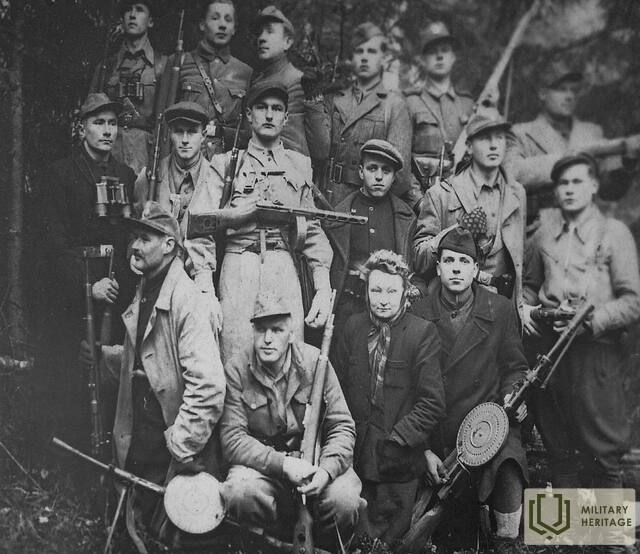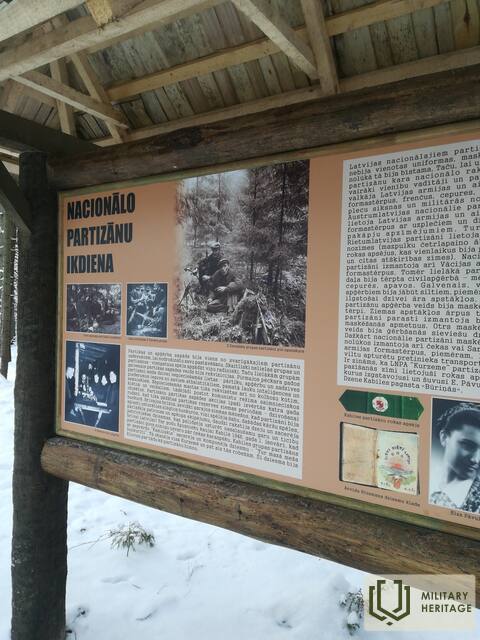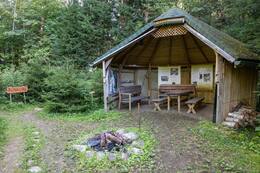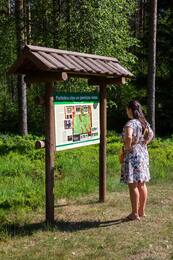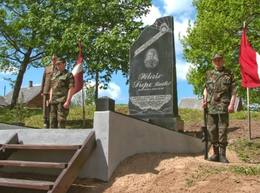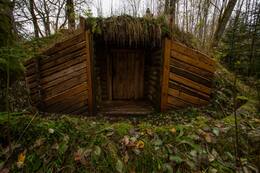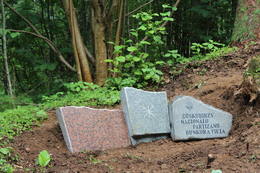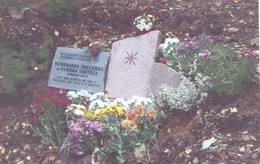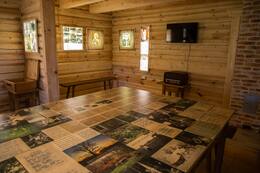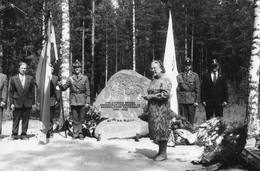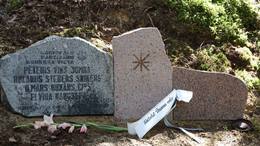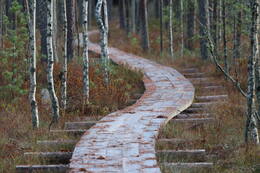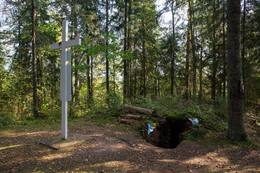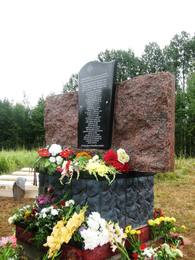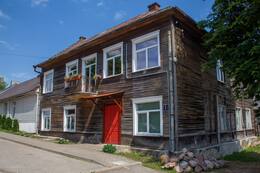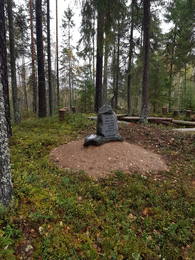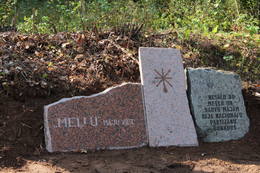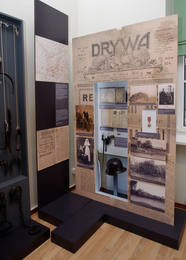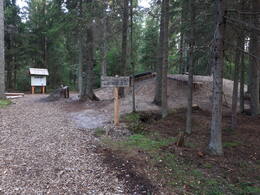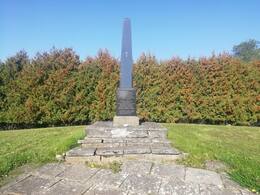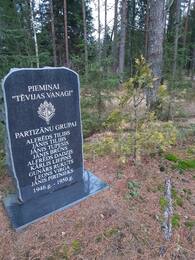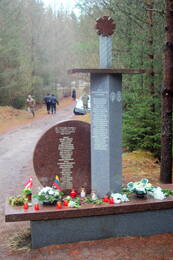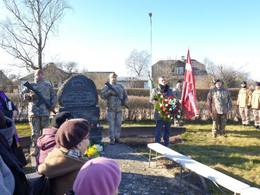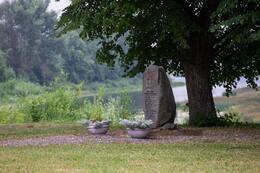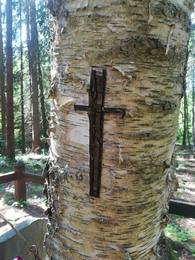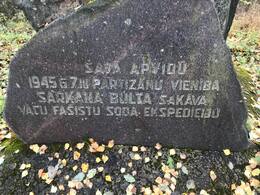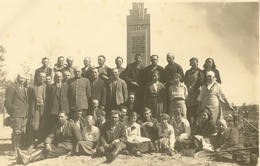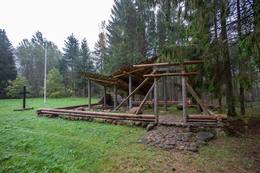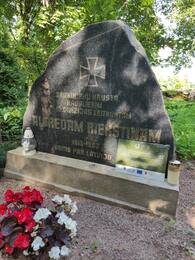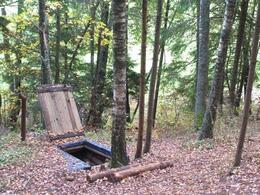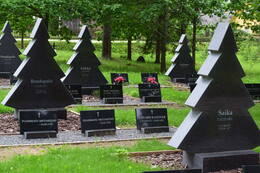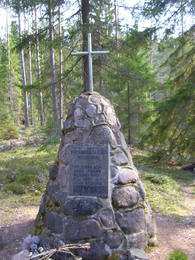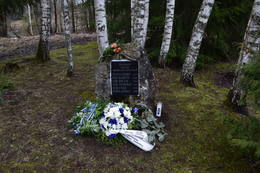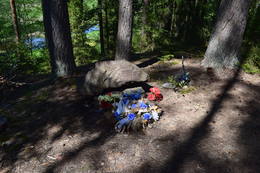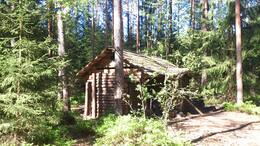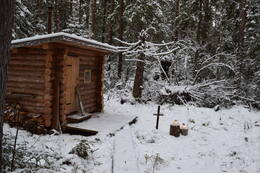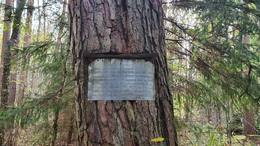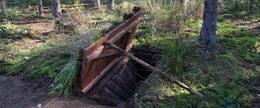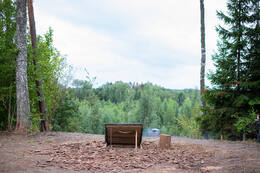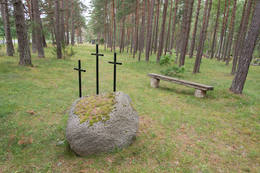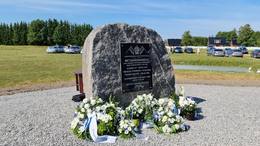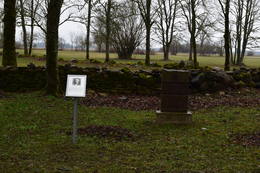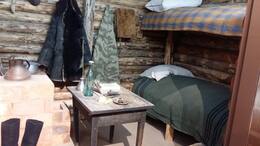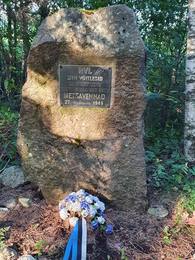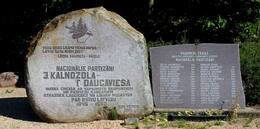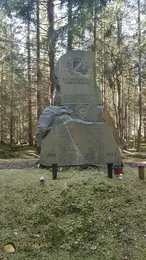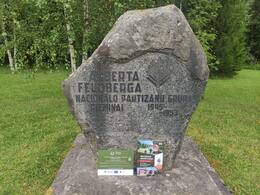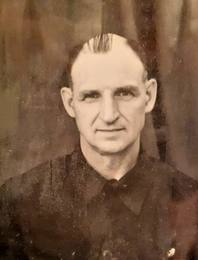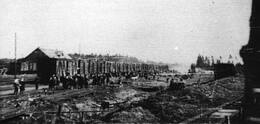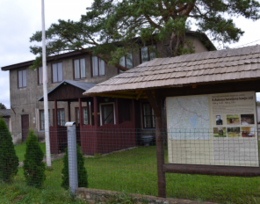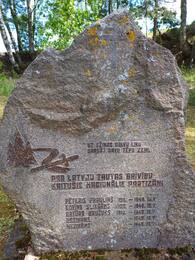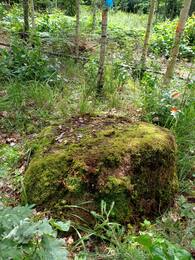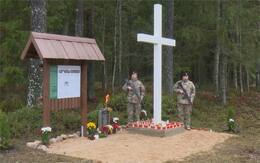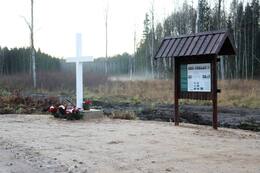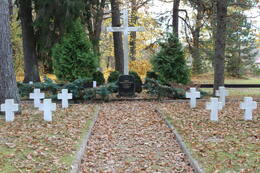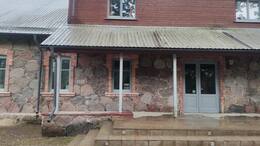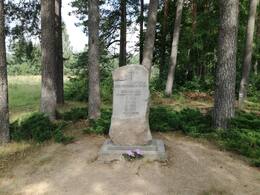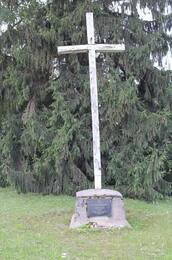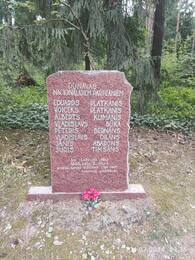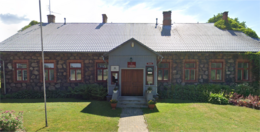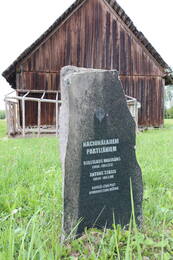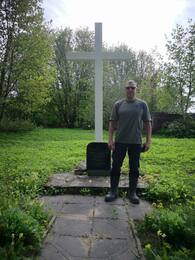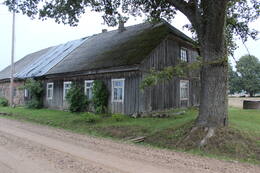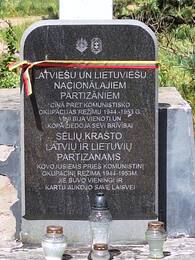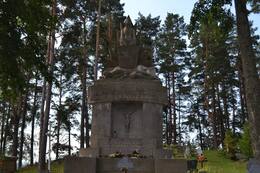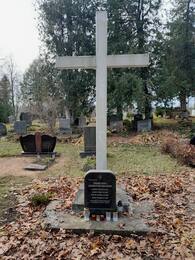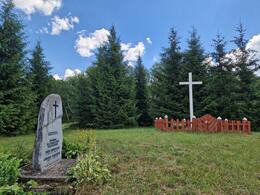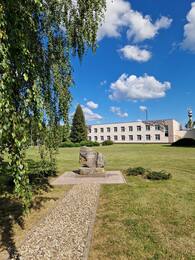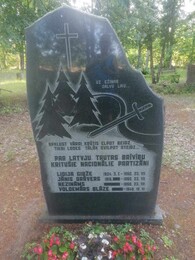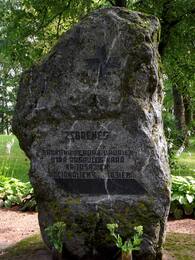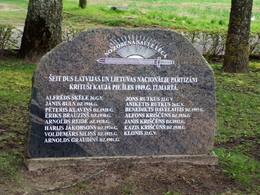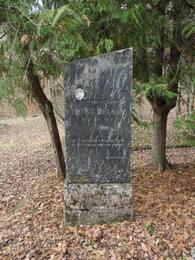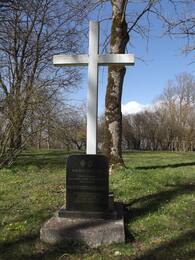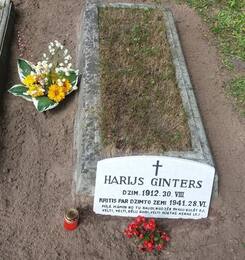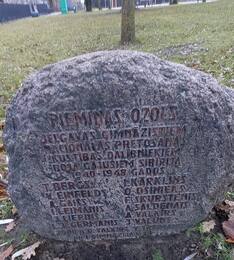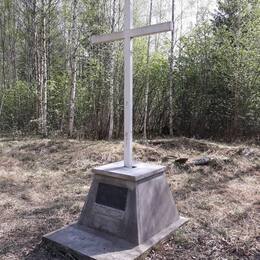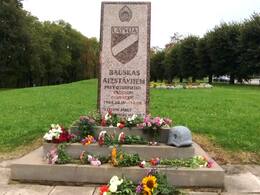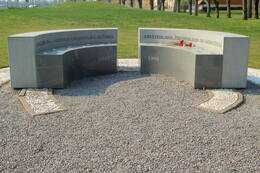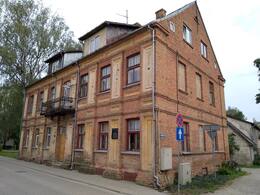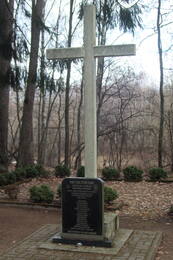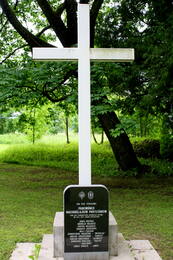Tautiniai partizanai/ Miško broliai
II WW2, III Nacionaliniai partizanai
Nacionaliniai partizanai arba miško broliai buvo nedidelės, ginkluotos vietos gyventojų grupės, kurios 1944–1956 metais Latvijos teritorijoje kovojo savarankiškas kovas su SSRS okupaciniu režimu.
Priversti slėptis miškuose, tai buvo žmonės, kurie negalėjo ar nenorėjo gyventi Sovietų Sąjungoje. Jie buvo Latvijos gyventojai, kovoję su SSRS okupaciniu režimu nuo 1944 m. rugpjūčio mėn. iki 1957 m. gegužės mėn. per ginkluotą kovą ir partizaninį karą.
Partizanų kautynės su okupacinių režimų pajėgomis vyko nuo 1944 m. vasaros pabaigos.
Iš viso Latvijoje buvo apie 20193 miško broliai/nacionaliniai partizanai
Daugiau informacijos šaltinių
Latvijos nacionalinių partizanų kovos – nacionalinė enciklopedija (enciklopedija.lv)
Susijusi laiko juosta
Susijusios vietos
Bunker of national partisans – Forest Brothers
The Forest Brothers’ Bunker is located by the Riga-Pskov (A2) highway 76 kilometres from Riga and 11 kilometres from Cēsis. The Latvian national partisans or Forest Brothers were small, armed groups of local residents who fought their independent battles against the occupation regime of the USSR in the territory of Latvia from 1944 to 1956. Forced to hide in the forests, these were people who could not or did not want to live in the Soviet Union. A total of around 20,193 Forest Brothers operated in Latvia. The bunker was formed based on the stories and memories of former Forest Brothers about life in the forests, hiding and fighting for the independent state of Latvia after 1945. The bunker showcases armaments and household items. The personal belongings, weapons and photos of partisans are on display. The guide’s narration is enriched by a video from interviews with Forest Brothers. There is a place for picnic campfires by the bunker. It is possible to pre-order a soup prepared on the fire or enjoy an evening of outdoor cinema by the fire.
Battles and memorials of national and Soviet partisans in the Griva forest massif
It is located in the Griva forest massif.
Six objects related to the places of national and Soviet partisan battles are under consideration.
In the forest massif of Griva, there are not only the headquarters of the "Purvsaliņi" national partisans, the White Cross in the bunker of the national partisans and the cross to the commander of the resistance movement Andrejas Roskoš, but also the grave of the Soviet partisan brigade commander Artūrs Balož, a monument on the so-called Maiden Hill, where a Soviet partisan died in 1944 the group of young partisans of the brigade, as well as a monument to the Soviet partisans with a five-pointed star and the engraved words "Let's cover ourselves with needles".
It is also possible to view the objects by going for a ride with a two-wheeler on bicycle route no. 785 - "Rhymes of history in the forests of Griva" (route length 34 km, gravel and forest roads). Map for download.
Memorial place for the commander of the national partisan group Andrejas Roskoš (GPS 56.87399, 27.43524)
In the autumn of 1997, the White Cross was discovered in Lielgrivas forest for the commander of the national partisan group Andrejas Roskoš.
Monument to Artūrs Balodis (GPS 56.872926, 27.478121)
Artūrs Balodis was a Soviet partisan, the commander of special tasks of sub-unit A, which was stationed in the Griva forest massif. Fell in the extensive "combing" carried out by the occupiers of Nazi Germany. The comrades carved the letters AB in the birch tree at the place where he died, so that it would not be forgotten. After the war, local researchers found the marked birch and installed a commemorative plaque in its place.
For all those who fell in the forests of Griva (GPS 56.863280, 27.47975)
This commemorative stone in the Griva forest massif has been installed by VAS "Latvijas valsts meži" in honor of the partisans who fought for their homeland. Next to the memorial stone, there is a map-scheme with indications of the partisans' headquarters and places of interest. There is also a rest area. Nearby is the settlement of the national partisans, 1945-1947.
National partisans settlement (GPS 56.863456, 27.481148)
In this place there were settlements of national partisans who fought against the Soviet occupation. The places of individual bunkers have been preserved, by their visual appearance you can judge how big and what shape the dugouts were. National partisans, resisting the Soviet power, operated in the forests of Griva for several years after the end of the Second World War.
Griva forest memorial ensemble, dugout (GPS 56.860665, 27.490439)
It was built in memory of the Soviet partisans who lived in the forests of Griva. Guerrillas blew up the local railway network and trains to disrupt the supply of ammunition, food, etc. to the Nazi German army. Memorial stones have been placed in places where trenches were dug during the war. In the restored dugout you can feel the atmosphere of wartime.
Girls' hill (GPS 56.858187, 27.521526)
In June 1944, the occupiers of Nazi Germany carried out an extensive "combing" of the Griva forests with the intention of destroying the partisans. The soldiers on the hill of Numerne besieged the economic company, which consisted mostly of young girls, and all of them were shot. Since these tragic events, Numerne hill was renamed Meitenu hill by local residents. A memorial stone has been erected at this location.
Monument to the commander of the North-Eastern national partisans Pēteris Sup - "Cinītis"
Honoring the memory of the national partisan commander Pēteras Supes, on May 28, 2005, a monument dedicated to him was unveiled in Vilakas. It is placed near the Viļaka Catholic Church, on the edge of the trenches dug during the war, where the Chekists buried the shot national partisans. A capsule with the names of 386 fallen national partisans, battle descriptions and materials about the partisan commander is placed under the monument dedicated to P.Supem. The words engraved in stone: "I remained faithful to you, Latvia, until my last breath".
The monument was created by Pēteris Kravalis.
Next to it is a memorial place in the Stompaki forest and other places of battle for Latvian freedom fighters who fell and were murdered by the Chekists in 1944-1956.
On June 20, 2008, a granite plaque with the names of 55 fallen partisans arranged in three columns was discovered on the right wall.
The monument was erected in the place where the communist occupation authorities once displayed the remains of the murdered partisans to intimidate the rest of the population.
Words of thanks to Pēteris Supe and a poem by Bronislava Martuževa are engraved on the adjacent plaque:
"Get up, Peter Supe,
Soul, in battle!
Today Your blood sacrifice,
Risen in the nation.
Go out to live forever
In the strength and vigor of the young,
Wraps, flutters, folds
In the rising flag!"
Memorial site of national partisans in Sērmūkši
Sērmūkši is home to one of more than a hundred memorials to partisan battles in Latvia. There are more than six hundred partisan battle sites in Latvia. A Latvian national partisan dugout has been built based on historical evidence, and visitors can spend the night in near-authentic conditions with plank beds, lighting provided by kerosene lamps and a heating device similar to the ones used by partisans. Visits must be booked in advance. The fateful moment for the Sērmūkši National Partisan Group came on 29 November 1946 with the deaths of four fighters from the group: Jānis Zīrāks, Reinholds Pētersons, Jānis Pīlands and Anna Zariņa. Alfrēds Suipe survived, endured deportation, returned to Latvia and saw the restoration of a free state. He initiated the idea to establish a memorial site for his fallen companions in Sērmūkši.
Memorial stone to the national partisans of Alsviķi parish "Snake Square"
Located in "Čūskubirzs", Alsviķi parish, Alūksne district.
The memorial stone was unveiled on August 21, 2018. Akmeņkalis Ainārs Zelčs.
A bunker site has been preserved here in the forest massif, where in June 1947 the head of the communications department of the Latvian National Partisan Association Antons Circāns came to meet with the partisan representatives led by Bruno Bucalder to organize and maintain contacts between certain groups of national partisans. Anton Circan's goal was not achieved, because on July 7, 1947, near Drusti, he died.
Memorial plaque to Veclaicene national partisans instead of a bunker
Located in Veclaicene parish, Alūksne region.
Opened on October 4, 2019. Akmeņkalis Ainārs Zelčs.
On March 13, 1953, in the forests of Veclaicene, not far from the Koruļi house, the Chekists opened a carefully disguised bunker and arrested Bernhard Ābelkok and Elmārs Tortūze.
Weapons were found in the bunker: 2 German rifles and 95 rounds, 2 Parabellum pistols and 152 rounds.
On November 11, 1949, Czech agents K. Dokti-Doktenieki were shot and his group broke up. After the attack, B. Ābelkoks and E. Tortūzis hid for some time in a bunker near the Maskaļi house, but from the spring of 1951, with the support of Ilona Ābolkalns, they built a bunker in Koruļi, where they lived until their arrest.
Broņislava Martuževa poetry barn
The Broņislava Martuževa Museum is situated on the site of the poet’s childhood home in Indrāni parish, Madona municipality. The museum’s exhibit is located in a renovated barn featuring voice and video evidence from the National Resistance Movement and the work of the poet in publishing an underground magazine, as well as composing poetry and songs for national partisans. Broņislava Martuževa was involved with the resistance movement since its inception. Lazdiņas, Martuževa’s home which has not survived, also served as a place of refuge for Pēteris Supe, Head of the Latvian National Partisan Association, and his comrades-in-arms. The poet spent five years hiding in the basement of her home, meeting with partisans, writing poetry (including work dedicated to partisans Pēteris Supe, Vilis Toms, Smilga Group, Laivenieks, Salns, Celmiņš, Bruno Dundurs and others), as well as writing songs and teaching them to partisans. Now, her songs are sung by the ‘Baltie lāči’ group (literally: ‘White Bears’). In 1950, the ‘Dzimtene’ magazine (literally: ‘Motherland’) was published underground together with Vilis Toms. The poet transcribed 11 issues of the magazine, 10 copies each, by hand. The poet, her brother, sister, mother and Vilis Toms were arrested in 1951. Bronislava Martuževa returned from Siberia in 1956. Recognised locally and nationally, the poetry barn is visited by both local residents and guests of the municipality. Learning about the poet’s life gives you the opportunity to discover the fate of Latvia.
Memorial to the fallen soldiers of the Latvian Legion and national partisans
Located in Indrāni Parish, Lubāna New Cemetery.
A memorial place to the fallen soldiers of the Latvian Legion and national partisans can be seen
The memorial was opened on July 25, 1992. The memorial stone was created by Andris Briezis.
At the beginning of the Awakening, in October 1990, Kārlis Doropoļskis, a member of the Helsinki 86 human rights group, received permission from the authorities to resume the joint burial of Latvian legionnaires the cemetery of the brothers, which was arranged in the new cemetery of Lubāna. A total of 26 fallen legionnaires and national partisans were buried in the brothers' cemetery.
Memorial to the bunker of the national partisan group "Jumba"
Located in Ziemera Parish, State Forest Quarter 66.
The memorial site was unveiled on July 10, 2020.
In the second stage of the Latvian national partisan movement, in the middle of 1948, a group of 4 people - Viks Pētersi, Stebers Rolands, Bukāns Ilgmārs and Kangsepa Elvīra separated from J. Bitāna-Liepačs unit in Mālupe-Beja parishes and . The location of the partisans was near the Estonian border, near the Riga-Pskov highway, on a hill in a thoroughly built bunker.
On March 2, 1950, when the Chekists opened the bunker, the partisans hid in a barn made of boulders on the Estonian side of Napke's house. After a long and intense shooting on March 3, 1950, the Chekists managed to set fire to the barn. Ilgmārs Bukāns, Rolands Stebers and Elvira Kangsepa burned down together with their newborn daughter. Peter Wick jumped out of the barn window and hid in the attic of the house, where he was also found and shot. The farm was burned. The bodies of all the fallen partisans were taken to Alūksne. A memorial was erected at the site of the fighters' deaths in the early 1990s. Elvira Kangsep's daughter, born in a burning barn, was given the name Liesma.
Nacionalinių partizanų būstinė gamtos draustinyje „Stompakų pelkės“ (Stompaku purvi)
Antrojo pasaulinio karo metais Stompakų pelkėje buvo viena didžiausių nacionalinių partizanų būstinių Baltijos šalyse. Šiandien ši teritorija priklauso Stompakų gamtos draustiniui.
Pelkių salose esančią gyvenvietę galima pa siekti pažymėtu pėsčiųjų taku. 1945 m. pradžioje Stompakų pelkėje buvusioje nacionali nių partizanų būstinėje gyveno 350–360 žmonių, iš jų – 40 50 moterų. Joje buvo 24 gyvenamieji bunkeriai – pusiau į žemę įkasti statiniai, kuriuose galėjo gyventi 3–8 žmonės. Būstinėje taip pat veikė kepykla, požeminė bažnyčia ir trys antžeminės pašiūrės arkliams. Partizanai rengė išpuo lius prieš okupacinio režimo pareigūnus. 1945 m. kovo 2–3 d. čia vyko Stompakų mūšis – didžiau sias nacionalinių partizanų susirėmimas Latvijoje. Būstinė je buvusius 350–360 partizanų puolė NKVD 143-asis šaulių pulkas ir vietinio stribų (rus. „isterbiteli“) bataliono kovoto jai – iš viso 483 vyrai. Mūšis truko visą kovo 2 dieną. Kovo 3-iosios naktį partizanams pavyko ištrūkti iš būstinės ir pasi traukti į ankstesnės bazės vietą. Mūšyje žuvo 28 partizanai, o NKVD neteko 32 karių. Šiuo metu Stompakų būstinės vietoje yra atkurti trys bun keriai – bažnyčia, štabas ir gyvenamasis bunkeris, taip pat 21 bunkerio vieta. Įrengti informaciniai stendai apie būsti nę ir mūšį. Galima užsisakyti ekskursijas su gidu.
Vesetos partizanų žeminė ir atminimo vieta „Baltasis kryžius“ (Baltais krusts)
Vesetos partizanų žeminė ir atminimo vieta „Baltasis kryžius“ yra Vesetos užliejamos pelkės teritorijoje. Po Antrojo pasaulinio karo Vietalvoje veikė vadinamoji Parupo partizanų grupė. Jai vadovavo Richardas Parupas (1914–1946), buvęs vokiečių kariuomenės 15-osios latvių divizijos seržantas. Karo metais jis dalyvavo nacionalinių partizanų veikloje Jėka bpilio ir Maduonos apylinkėse. Per neilgą gyvavimo laikotarpį Parupo grupė surengė daugiau kaip dvidešimt ginkluotų susirė mimų su tuometės Vidaus reikalų ministerijos daliniais. Čekistų pulkininko Kotovo ataskaitoje savo vadovybei Rygoje teigiama, kad dėl šios grupės veiklos sovietinės valdžios įsitvir tinimas Jekabpilio ir Maduonos rajonuose buvo paralyžiuotas. Parupo vadovaujami nacionaliniai partizanai surado ir sunaikino kelis tremiamųjų sąrašus, taip išgelbėdami daugelio žmonių gy vybes. Kadangi atviroje kovoje nacionalinių partizanų būrio su naikinti nepavyko, Saugumo komitetas į jį infiltravo keturis čekistų specialiosios grupės narius. 1946 m. liepos 2 d. naktį šie agentai nušovė dešimt būrio partizanų, tarp jų ir Richardą Parupą. Nužudytųjų palaidojimo vieta nežinoma, tačiau Rygos brolių ka pinėse įrengta jiems skirta atminimo lenta. Prie Vesetos partizanų žeminės stovi paminklas „Baltasis kryžius“ – 3 m aukščio baltas kryžius su lenta, kurioje iškalti 1946 m. liepos 2 d. žuvusių partizanų vardai ir pavardės.
Monument to members of the resistance movement in Stompakis
It is located 15 km from Balvi in the direction of Viļakas, on the right side of the road.
A memorial is visible.
The memorial to the members of the resistance movement, dedicated to the memory of the national partisans of Pēteras Supes who fell in the battles of March 2 and 3, 1945, on the side of the Balva - Viļaka highway opposite the Stompaki swamp, was opened on August 11, 2011, on the day of remembrance of Latvian freedom fighters. At the end of July, a capsule with a message for future generations was embedded in the base of the monument. A document with the names of 28 national partisans who fell in the battles of March 2 and 3, 1945 is placed in the capsule.
"In February 1945, Latvia's largest national partisan camp was established on the islands of the Stompaku swamp, which the people began to call the islands of the Stompaku swamp, 2 km from the Balvu - Viļaka highway, where 360 people lived in 22 dugouts. Among them, some legionnaires who, for the legion division retreating, they had stayed at their father's house with all their weapons. In order to destroy the partisans, on March 2, 1945, the soldiers of two battalions of Czech troops attacked the dugouts together with destroyers, which also had four mortars in their armament. The battles took place all day, the partisans resisted stubbornly, and the attackers suffered suffered great losses, so that they could not capture the camp and destroy the partisans. 28 inhabitants of the Stompaku swamp had also fallen or died after being seriously injured in the battle. The next night, the partisans broke the siege of the camp with a battle and left undefeated" - this is what a member of the national resistance movement of the award department writes about the Stompaku battle chairman of the case commission, Zigfrīds Berķis.
Privati ekspozicija „Abrenės kambariai“ (Abrenes istabas)
Privati ekspozicija „Abrenės kambariai“ įsikūrusi Viliakos mieste, istoriniame pastate. Iš pradžių šis pastatas stovėjo senosios Marienhauzeno turgaus aikštėje. Vėliau čia vei kė butai, biurai, įvairios parduotuvės, o Antrojo pasaulinio karo metais – latvių savigynos štabas, gestapas ir čekistų būstinė. Ekspozicijose pristatomi įvairūs Viliakos ir jos apylinkių isto rijos laikotarpiai bei įvykiai nuo 1920 iki 1960 metų – kai miestelis priklausė Jaunlatgalės, vėliau Abrenės apskri čiai. Tarp eksponatų – Stompakų pelkės partizanų štabo daiktai, pasakojantys apie nacionalinį pasipriešinimą Lat galoje, taip pat dokumentai ir fotografijos iš Nepriklauso mybės kovų laikotarpio. Naujausioje ekspozicijoje lankytojai gali susipažinti su ka daise garsia motokroso trasa „Baltasis briedis“.
Memorial place "Bitan bunkers"
Located in Mālupe Parish, Alūksne District.
The memorial stone was unveiled on October 13, 2017. Akmeņkalis Ainārs Zelčs.
On August 24, 1945, in the Dubna forests of Latgale, the Latvian National Partisan Association (LNPA) was established with the aim of restoring the Republic of Latvia in 1918. Regional headquarters were set up to better coordinate the activities of the guerrilla groups. National partisan groups operating in Beja, Mālupe and Mārkalne parishes united in the Priedolaine sector. The regional headquarters was headed by Jānis Liepacis. Propaganda divisions were established at each regional headquarters. One of them, the commander of which was Jānis Bitāns, was formed in the forest massif of Mālupe parish. Here, in the bunker, from 1946 to 1948, five press publications of the Latvian National Partisan Association “Mazais Latvis”, “Liesma”, “Auseklis”, “Māras Zeme” and “Tautas Sargs” were printed. The youth resistance movement “Dzimtenes Sili” of Alūksne Gymnasium was involved in the preparation and dissemination of information.
Memorial stone in Ilzen near the houses of "Sarvu" and "Melļ"
Located in Ilzene Parish, Alūksne District.
The memorial stone was unveiled on September 28, 2018. Akmeņkalis Ainārs Zelčs.
From the autumn of 1944, the inhabitants of these Ilzene parish houses supported the national partisans led by Voldemar Anderson ("Old"), whose bunker was located in a thicket near the forest. On November 23, 1945, the bunker was surrounded by NKVD soldiers. Nine fighters were killed in the battle. After it, 2 machine guns, 14 submachine guns, 11 rifles, 10 pistols, 3,500 rounds, 45 grenades, 4 binoculars were found. The destruction of Voldemar Anderson's group was planned in the case of the Czech agency "Chain" ("Цепь").
The group consisted of Voldemārs Pāvels Andersons (“Old”), Gaston Dzelzkalējs, Voldemārs Tonnis, Centis Eizāns, Osvalds Kalējs, Jānis Koemets, Stāvais (“Polis”), Voldemārs Rappa, Eduards Rappa, Elmārs Rappa (survived).
Preiļi Museum of History and Applied Art exhibition "Museum stories for Latvia"
It is located in the premises of the Preiļi Cultural Center.
Preiļi Museum of History and Applied Art (PVLMM) exhibition "Museum stories for Latvia" about the First World War, the War of Independence and the Second World War can be viewed.
The "Story of Drywys" section of the exhibition "Museum Stories for Latvia" (opened in 2018) of the Museum of Preiļi History and Applied Arts is dedicated to the First World War, the War of Independence and the liberation of Latgale, as well as to the knights of the Lāčplešana War Order. The exhibition section "The story of the flag" tells about the difficult events of the Second World War period, during which the people of Preila were affected by deportations, the Holocaust, involvement in the military units of the warring parties, and after the war - in the ranks of national partisans. The "Righteous Among the Nations" medal awarded to Vladislav Vuškānas, the savior of the Jews from Preiliat, can also be viewed.
Upon prior application, a tour is available in Russian and English.
Pēteris Čevers national partisan bunker
The bunker of the national partisans of Peter Chever is located in Lauciene municipality, about 4 km from the Talsi-Upesgrīva road. A trail covered with wood chips leads to the bunker. The renovated 31 square metre bunker is made of a concrete frame finished with half-logs of logs to create an authentic feel.
Captain Chever's group completed the bunker in the forest near Vangzene at the end of October 1949. It was planned to survive the winter of 1949-50. On 3 February 1950, the local forester betrayed the partisans and the bunker was attacked by a Cheka unit of more than 300 soldiers. At that time there were 19 people in the bunker - 17 men and two women. Six partisans fell in this unequal battle, but the others managed to break through two chains of Cheka siege by fighting their way through. By the end of the winter the partisans took refuge in surrounding houses with their supporters, but in the spring the group reunited until it was captured and destroyed in November 1950. After an attack by Cheka troops, the bunker was blown up and before it could be rebuilt, only a water-filled pit remained.
Zlēku Tragedy Memorial Site
The memorial is located near the Zlēki Manor ensemble, in the western part of Karātavkalns. Around twenty boulders with the names of the people killed form a circle, and in the centre is a black marble obelisk about three metres high.
Some of those killed have been reburied at the Zlēki memorial.
In December 1944, in the vicinity of Zlēki, the German Nazi army carried out a large-scale operation against the civilian population.In the combat action log of Army Group Nord, an entry was made at 17.30 on 9 December 1944 that 161 people belonging to the "Rubens Brigade and units of the Red Arrow" had been killed on the enemy side during the action. In Soviet times, this figure was apparently taken as the total number of victims of the Zlēki tragedy, referring to civilians killed.
The course of the action is partly documented in the report of the head of the counter-intelligence section of the German 16th Army of 31 December 1944. It explains that from 5 to 9 December, under the leadership of the highest SS and police leader in Ostland, SS Oberruppenführer and Police General Friedrich Jekeln, a large-scale operation took place at Eichensumpf ("Oak Swamp") against the "Red Arrows" and the remnants of General Kurel's group at Abava.
"Dunci's bunker" and memorial plaque to "Tēvijas vanagi" (Patriotic Hawks)
The "Duncs Bunker" with the memorial plaque "Patriotic Hawks" is located in Otaņķu municipality, in the place where the first bunker of the partisan group of the national resistance organisation "Patriotic Hawks" was located.
In the winter of 1945/46, in the village of Ķīburi in Barta parish, three patriotic men, led by Alfred Tilib (a former legionary of the 19th SS Division), founded the national resistance movement "Tēvijas Hawks", which soon had about 200 members from different places: Liepāja, Aizpute, Nīca, Dunika, Grobiņa, Barta, Gavieze. This movement fought for the liberation of Latvia.
The size of the bunker in which the partisans were housed was 4 x 4 m and was made of thick, horizontally laid logs. It was entered from above through a trapdoor with a small pine tree growing out of it, under which was a ladder. The hatches were on two floors, each with a place for 7-8 men to sleep. Unfortunately, the bunker was found and blown up in 1947.
Today, a depression can be seen in the ground where the bunker was. The site is located in the forest and can be freely accessed by anyone at any time without prior reservation.
A picnic area with a shelter is available nearby.
The memorial plaque was unveiled on 9 September 2005. The granite stele was erected by the Latvian National Partisans' Association in cooperation with the Municipality of Nīca, the Barta Forestry and the Rudes Primary School.
The object has the status of a cultural and historical monument of the region
Ylės nacionalinių partizanų bunkeris
Bunkeris yra Zebrenės seniūnijoje, Ylės girininkijoje, išsukus iš kelio P104 Bikstai–Aucė.
Ylės nacionalinių partizanų grupė, kuriai vadovavo Karlis Krauja, susikūrė 1947 m. Grupės vadu buvo išrinktas V. Ž. Briz ga (slapyvardis K. Krauja). 1948 m. spalį ši grupė susijungė su lietuvių nacionalinių partizanų grupe. Kraujos grupė veikė Jelgavos apskrityje, joje buvo 27 nacionaliniai partizanai. 1948 m. spalį Jelgavos apskrities Lielaucės valsčiuje, netoli Ylės girininkijos, 300 m į šiaurę nuo sodybos „Priedaiši“, Krau jos grupė įsirengė požeminį bunkerį. Jo bendras ilgis, įskai tant slaptus priėjimus, buvo 45 metrai. Aplink bunkerį buvo išdėliota 70 nuotoliniu būdu valdomų minų. Bunkeryje buvo įrengta krosnis, šulinys, tualetas ir sandėlis. 1949 m. kovo 17 d. bunkeryje buvę 24 partizanai stojo į savo paskutinį mūšį su 760 Valstybės saugumo ministerijos (čekis tų) karių. Po mūšio 9 partizanai buvo suimti, o 15 žuvo, iš jų – 8 latviai ir 7 lietuviai. 1992 m. krašto apsaugos kariai kartu su Dauguvos vanagais atkūrė susprogdintą bunkerį. Toje vietoje pastatytas Baltasis kryžius, paminklinis akmuo ir granito stela. Bunkerio viduje yra krosnelė, stalas ir siauri gultai, ant kurių miegojo partizanai.
Prie bunkerio yra informacijos stendai, paminkliniai akmenys su partizanų vardais ir pavardėmis.
National Partisans Memorial Site on Striķu Street, Saldus
The memorial is located at the intersection of Striķu and Lauku Street.
The tragically bloody event that took place at this place took place during peacetime on 24 February 1950 in Saldus, on Striķu (then 5. augusta) Street, near the 33rd and 35th houses. In the 33rd house of this street, after the destruction of the Zemgale group of forest brigades with its headquarters bunker in the forests of Īle in March 1949, three forest brigades were still alive and uncaptured, including the group commander himself, Kārlis Krauja (real name Visvaldis Brizga), and his associate Vilis Krusts. They had hoped to spend the winter of 1950 at the Bergmanis' home in Saldus, but they were rounded up and tracked down. The two houses were besieged by about 30 Chekists and a fierce battle took place early in the morning. The Chekists were fired on from both houses, but, losing to overwhelming odds, the two partisans tried to escape to the nearby Veide forest. However, the Chekists shot partisan Krusta already on the stairs of the house, and Krauja - about 80 metres further towards the forest.
Both houses were set on fire, the occupants having been asked to come out beforehand and promised that their lives would be spared. There are reports that people did come out, but they were shot on the spot anyway. Among the people shot or suffocating in the smoke were the father and son Kursinski from House 35, who had supported the partisans, but also Leontine Ezerkalni, a resident of the Kursinski house, who had no knowledge of her landlord's connections with the forest brigades, was shot.
Memorial stone to the Rihards Pārups group of national partisans
It is located on Rīgas Street near the Krustpils Lutheran Church.
On September 22, 1996, a memorial stone to Rihards Pārups and the group of national partisans led by him was unveiled in Krustpilis. The memorial stone was created by the sculptor Ilgvars Mozulāns, but its creation was financially supported by the speaker of the Saeima, Ilga Kreituse. This event was organized by the board of the National Partisan Association of Latvia.
Rihards Pārupa's national partisans,
who were murdered by the Cheka special group
Rihards Pārups (1914 - 1946 2.VII)
Group commander
Rihards Stulpiņš (1923 - 1946. 2. VII)
Alberts Avotiņš (1912 - 1946. 2. VII)
Eric Juhna (1928. -1946. 2. VII)
Aleksandrs Lācis (1919 - 1946. 2. VII)
Pēteris Lācis (1921 - 1946. 2. VII)
Jānis Ēvalds Zālītis (Āboliņš) (1911 - 1946 2. VII)
Siegfried Bimstein, Theodor Schmidt (... - 1946. 2. VII)
Uldis Šmits (... - 1946. 2. VII)
Pēteris Lazdāns (1926 - 1947. VI)
Eric Konvals (1929 – 1947. VI)
Niklas Ošiņš (1908 – 1954. 12.X) – executed in Riga
Alberts ħiķauka (1911 – 1972. II) – imprisoned in the Mordovian camp
Rihards Pārups was born on June 11, 1914, in "Kakšiš" of Krustpils parish. During the Second World War, he was a sergeant in the anti-tank division of the 15th Latvian Division. Participated in national partisan operations in the vicinity of Jēkabpils and Madonas and was a member of the National Resistance Movement, unit leader in the vicinity of Jēkabpils and Madonas. Rihards Pārups fell in battle with Czech troops on July 2, 1946 in Vietalva parish. Unfortunately, the burial place is unknown. A commemorative plaque has been installed in the Riga Brothers' Cemetery. In the fall of 1945, a group of national partisans, led by R. Pārups, was formed in the Jēkabpils district. During its short existence, it participated in more than twenty armed clashes with units of the then Ministry of the Interior. In the report of Cheka's colonel Kotov to the Riga headquarters, it is stated that the activities of the Soviet authorities in Jēkabpils and Madona districts were effectively paralyzed as a result of the group's activities during this time. The national partisans led by R. Parupa found and destroyed several lists to be sent out, thus saving the lives of many people. The leadership of the Security Committee, unable to destroy the national partisan unit in an open battle, infiltrated into it four people from the Czech special group, who shot ten partisans of the unit, including R. Parup, on the night of July 2, 1945. In 1947, two more were shot near Jaunkalsnava, and in 1951, one member of this unit was shot. After twenty-five years of hard labor in the Mordovia camp, a few days before liberation, the fourteenth partisan of the group led by R. Parupas died.
National Partisans battle site near the Apūznieki home
On 1 January 1946, one of the biggest battles between the national partisans and the Cheka, or Soviet occupation State Security Committee, took place between Kabila and Renda near the "Apūznieki" houses. The partisans, among whom was the commander of the group, Fricis Kārkliņš, went after hay on the horses of the forest brigades. He left Ēvalds Pakulis as commander. The scouts reported that a Cheka unit was approaching the dugouts. Pakulis sent a partisan detachment - 25 well-armed men - to meet them. The bullets of the enemy wiped out the lives of three men - Kārlis Kristolds, Emītis Šmits and Ādolfs Kūrējs - but about 50 men fell on the Cheka side. Two of the fallen men are buried in the forest where these events once took place, and a memorial to them has been created.
Today, new bunkers are being discovered in the forests, which once sheltered almost 20 000 people who did not support the Soviet occupation and were uncooperative, or who hid in the forests for other reasons, such as fear for their lives, safety, etc.
Memorial stone of the Soviet partisan unit "Red Arrow"
The Soviet partisan unit was formed on 30 September 1944, when 19 soldiers of the German 283rd Police Battalion, under the leadership of Vladimir Semyonov, deserted with their weapons. The battalion was formed in 1943 from volunteers from the Latgale region and took part in the anti-partisan operations of the German occupation authorities in the territory of Latvia and Belarus.
The unit was called "Semyonov Unit" after its commander and only at the end of the war adopted the name of "Red Arrows", which was already spread by Soviet propaganda after WWII. By December 1944, the unit had 300-400 partisans. Most of them were escaped Red Army soldiers, former Legionnaires, including fighters left after the destruction of General Kurel's group. Although many Red Army reconnaissance groups were active in Kurzeme at this time, they avoided close cooperation because the activities of the commander of the partisan unit and its main core in the ranks of the German police were too suspicious. The Red Arrow's activities were relatively poorly organised and more focused on waiting for the end of the war. During its activities it carried out extensive terrorising of the local population.
Vladimir Semyonov, the first commander of the Red Arrow, drowned on the night of 10 December 1944 while knee deep tried to cross the swollen Abava River. His corpse was found only in the spring of 1945 and buried. He was reburied in Kuldīga in 1961.
The monument is located on the site of the "Red Arrow" and other guerrilla camps in the area (about 50-70 people), which on 7 March 1945 was surrounded and attempted to be destroyed by German troops.
Monument to the soldiers of Anna Parish who died in the First World War and the Latvian Liberation War
Located in the central part of Anna parish Ezeriņi cemetery.
In the cemetery, where the burials have been made since 1925, there is a monument to the soldiers of Anna Parish who died in the First World War and the Latvian Liberation War, built with the funds collected by the Department of Guard of Anna Parish and unveiled in 1933. Until the Second World War, the guards of Anna Parish took care of the care of the monument, who went to the cemetery every Sunday and laid flowers in honor of the fallen. On November 18, 1940, the monument was shot, and the footprints of the bullets are still visible. Today, the cemetery commemorates Lāčplēsis Day every year.
In 2004, a memorial to the politically repressed in 1941 and 1949 was unveiled in the cemetery, and in 2006 a memorial plaque to the national partisans was unveiled.
Historical Exposition “The Burning Conscience”
The historical exhibit ‘Fire of Conscience’ is located in Cēsis, near the Cēsis Castle Square. Established in a Soviet-era temporary detention facility, it tells about the occupation of Latvia and reveals surprising and heroic stories of resistance from individuals. The yard features a memorial wall with the names of 643 residents of the former Cēsis district who died in Soviet repressions, including national partisans deported in 1941 and 1949 and those shot and sentenced to death. The exhibit’s timeline encourages visitors to study the course of the occupation of Latvia from 1939 to 1957. Arranged by topics, quotes from local newspapers offer a comparison of the political propaganda of the two occupation regimes. The six cells for temporary detention have survived to the present day in their original form from 1940 to 1941 and the post-war years. Here, the residents of Cēsis district, detained for various anti-Soviet activities, including national partisans, their supporters, young people who distributed anti-Soviet leaflets and other ‘traitors of the motherland’, were held for several days during the initial investigation and interrogation before being sent to the main KGB Building in Riga. Everything here is real: cells with iron doors, built-in ‘kormushkas’ (small openings for providing food), plank beds, a latrine for detainees, a small kitchen with an oven, as well as typical Soviet-era oil paint on the walls. In 2019, the exhibit was ranked third in the national design competition, the Latvian Design of the Year Award.
Memorial to the national partisans led by Dailonis Breiks "Daiņkalni"
Located in "Daiņkalni", Rauna parish, Rauna district (near Smiltene district, Brantu parish "Mežviju" house.
Getting to the memorial site only once a year - on April 16! The road leads through private property.
The memorial site is located on the site of the former “Daiņkalni” and “Graškalni” houses in Rauna Parish, under which a group of national partisans led by Dailonis Breiks (nickname Edgars, 1911-1952) hid in the bunkers created from 1950 to 1952. The group of D.Breiks' national partisans was established in 1948 and until 1950 they lived in "Jaunvieslavēni" of Gatarta parish with the owner Kārlis Lāčs. In 1950, D.Brixis' partisan group was handed over by his own brother Laimonis, so they were forced to move. During the summer they lived in the forests, but the winters were spent in Rauna parish “Daiņkalni” near the forester Artūrs Pērkons (1907-1952) and in the adjacent “Graškalni” bunkers set up under the house.
Since 2002, the memorial site in Daiņkalns has been gradually improved. Memorial events are held every year on April 16 to commemorate the national partisans led by Dailonis Breiks. In April 2003 and 2004, memorial crosses and plaques were erected near the houses of Daiņkalni and Graškalni. In the autumn of 2016 - in the spring of 2017, with the help of local Raunēni people, the memorial site was reconstructed according to the sketch of the architect Z.Butāns, as well as the site of the former bunker was excavated and strengthened.
Miško brolių sodyba Verumoje
Forest Brother Farm is close to the Latvian border in the village of Vastse-Roosa.
The bunker tourism attraction was opened in 1999, offering visitors a chance to experience the Forest Brothers’ way of life as a chapter in Estonian history. The programme includes searching for Forest Brothers in the hideout, visiting the bunker, learning about real-life events, singing Forest Brother songs with the host and sampling a Forest Brother meal or feast. The main attraction is the bunker, which is lined with narrow pine logs and embedded in the hillside. The bunker is furnished with bunk beds and a small table. These types of bunker were used during the late 1940s and early 1950s by hundreds of brave men in the resistance, burdened by the need to hide from the authorities.
Vastselinos miško brolių memorialas
Plans for this Forest Brothers memorial were hatched in early 2013, when the Internal Security Service identified the bodies found in a mass grave in Reedopalo near Võru. With the cooperation of Vastseliina municipality, the Võru regional unit of the Estonian Defence League and the Ministry of Defence, the location in the cemetery was decided upon and the necessary preparations were carried out. The reinterment of the 13 Forest Brothers took place on 21 September 2013. A year later, memorial sculptures designed by Mati Karmin were unveiled here, depicting small spruce trees carved out of stone. On 1 November 2015 a further four Forest Brothers whose bodies had been recovered from the secret mass grave in Reedopalo were reinterred here and more memorial spruces were unveiled in remembrance of those fallen in three different battles. Their actual graves remain unknown to this day.
Monument to Forest Brothers in Puutli
The Puutlipalo monument and bunker site is situated in the village of Mutsu in Võru County. On 28 March 1953 the last large-scale skirmish took place between the Forest Brothers and the Soviet security forces in Puutlipalo. All eight people hiding in the woods were killed – three women and five men. The bunker was destroyed and the bodies brought out of the forest and buried in an unknown location.
This monument, dedicated to the fallen Forest Brothers, was unveiled on 20 May 1989 near the former site of the bunker. It was the first monument to Estonian resistance fighters erected while the country was still under Soviet occupation and the Forest Brothers were still officially referred to as bandits. Contrary to many similar monuments erected later, which were blown to pieces by the communists, the monument in Puutlipalo remained untouched owing to its hidden location. The original stone tablet is the only feature to have been replaced, as it was mistakenly inscribed (due to years of being kept secret by the state) with the name of a resistance fighter who died in another battle.
DNA tests done during an investigation by the Internal Security Service in January 2013 revealed the identities of the eight Forest Brothers killed in Puutlipalo. On Resistance Fighting Day that year they were reinterred in the cemetery in Vastseliina.
Memorial to Forest Brothers in Saika
The Battle of Saika Bunker took place on 7 March 1951. The skirmish, which lasted for four hours, was one of the few in the history of the Forest Brothers in which the Soviet forces racked up losses comparable to those of the Forest Brothers themselves. Out of the eight Forest Brothers in the bunker, only two managed to escape. They were killed two years later in the Battle of Puutlipalo.
The memorial was opened on St John's Day in 2007 next to the main road. Avid hikers will also find the site of the bunker if they follow the forest paths south-east of the memorial for 700 metres. Battle site coordinates: 57°39'22.2”, 27°18'49.9" Note: Note that the coordinates carved into the Saika memorial spruce in the cemetery in Vastseliina are inaccurate.
Death site of last Estonian Forest Brother August Sabbe
Here, on 28 September 1978, two intelligence officers attempted to capture 69-year-old August Sabbe, who had been hiding from Soviet authorities for almost 30 years. However, capturing him alive proved impossible – following a scuffle, Sabbe threw himself into the Võhandu River and drowned. His body was recovered, taken to Tartu and buried in an unmarked grave in Raadi cemetery on 20 October that year. On the same day two decades later, his grave was marked with a tombstone. In 2002 a memorial to him was placed on the banks of the Võhandu River. Sabbe's pistol is on display in the Forest Brothers section of the main exhibition at Võru County Museum.
Pragaro dugno (Põrgupõhja) bunkeris
Põrgupõhja Bunker is situated in the woods near the village of Tiduvere in Rapla County.
By 1945 anti-Soviet dissent had developed into organised resistance movements in many occupied lands, including Estonia. Attempts were made to unify fighter groups and establish a network. This bunker, built in 1947, was an important stronghold for the Forest Brothers.
Fully reconstructed, Põrgupõhja Bunker was opened in 2015, showcasing the everyday life of the Forest Brothers. Anyone interested can spend the night in the bunker and imagine what it must have been like to live in hiding.
Adjacent to it is the original site of the bunker, which was destroyed by the NKVD on 31 December 1947, plus its surrounding dirt wall and a memorial to the fallen Forest Brothers.
Museum room on the Forest Brothers in Nursi Village Centre (with a memorial and a copy of a bunker nearby)
Entry is free and the museum room is open during the library's opening hours. The bunker is situated in an unrestricted part of the Defence Forces training area in Nursipalu. During training, gunfire can be heard in the vicinity. The last section of the road leading there may prove more demanding for drivers, but it is passable most of the time. The ground around the bunker can be wet.
The Battle of Lükka (Nursi) Bunker took place on 28 December 1945. Nine Forest Brothers were killed in the skirmish, and the aboveground bunker burnt down Three men managed to escape. The battle site was discovered after years of searching in 2008. A year later, a memorial to the battle was unveiled by the Võru-Valga road. The first excavations at the bunker site were carried out in 2010 and the museum room dedicated to the battle was opened that same year in the former schoolhouse in Nursi. (The typewriter used by the Forest Brothers is currently on display at Võru County Museum.)
Memorial to the Forest Brothers of Ehmja
After World War II, 20 men from Ehmja gathered to form a platoon of Forest Brothers. A log bunker was built in late 1945. The bunker was built on the ground and surrounded by a rampart. A shallow ditch surrounding the bunker substituted for a trench during emergencies. Eight metres from the site of the bunker stands a well 80 cm in diameter and 2.3 metres deep. On 20 January 1946, five members of the group were captured in a raid on one of the farms in Ehmja. For some reason, the men hiding in the bunker did not hear of this. The secret location of the bunker was known by the next day and was soon encircled by overwhelming forces. The Forest Brothers refused to surrender and were all killed in the hour-long shoot-out that ensued. Their bodies were taken to Haapsalu and buried in an unknown grave.
In September 2010 the ground beneath the bunker was investigated under the supervision of archaeologist Mati Mandel. They found 60 items: mostly bullet casings and cartridges, but also buttons, household items and more.
On 18 June 2011 a memorial was unveiled at the site of the bunker. This monument was made by the chairman of the Estonian Memento Union and Ungru Paekivi production manager Arnold Aljaste.
Forest brothers bunker in Lebavere
In 2020, a forest brother bunker was reopened in Lebavere forest. The bunker was created in 1944–1954 on the model of one of the bunkers of the forest brother Martin Tamme, who hid in the forest, based on the memories of his brother Kaljo Tamme. Martin Tamm lived in such a bunker for the last six years in the forest. In 2001, Väike-Maarja Parish built a bunker for visitors to visit, which was now out of date. Under the leadership of the Väike-Maarja Museum Friends Society, the same bunker and memorial plaque were restored in the forest.
For information and to visit the forest brother's bunker, contact the Väike-Maarja Museum Friends Society with the tour guide. Visiting the bunker with a tour guide is with a fee.
Ennuksemäe bunker site
Ennuksemäe forest brothers’ bunker is located in the forest between the villages of Holstre and Mustla. The hiding spot was built by brothers Jaan and Evald Sova who were escaping the Soviet occupation forces in 1944. Later, a dozen of other forest brothers joined.
On 21 February 1945, the members of the NKVD attacked the bunker and seven forest brothers and two attackers were killed and five people taken prisoner in a battle that lasted for six hours. To lure the forest brothers out, the communists set the bunker on fire. The Ennuksemäe bunker is the largest in the history of the Estonian forest brothers.
In 2010, Tarvastu parish restored the bunker to its approximate size, but on 31 October 2016, it was destroyed in fire, just like in 1945. Viljandi Parish Council decided to restore the bunker in 2020 and construction began in November the same year.
The reconstructed bunker has two entrances and exits, six bunk beds, a wooden stove and a tunnel that connects it to the entrance at the foot of the hill. The bunker built in 2021 is safer than the one destroyed in the fire five years prior, as in order to protect wood from damage, concrete walls and a concrete ceiling and floor were built.
The bunker is open 24/7. It is possible to visit and stay over night without prior registration.
Emmaste memorial to Forest Brothers
This boulder, embellished with three metal crosses, is dedicated to the Forest Brothers Priidu Mäe, Evald Pomerants and August Tuut, who were killed near Emmaste on 23 June 1951. Designed by Jaanus Rohusaar, the memorial was unveiled in Emmaste Cemetery in 2007.
Monument to the most famous Saaremaa Forest Brother Elmar Ilp and his cohorts
This monument is situated in the village of Luulupe.
It was unveiled in 2020 in memory of the most famous Forest Brother from Saaremaa, Elmar Ilp, and his cohorts.
Ilp was a thorn in the side of the Soviet authorities from 1944 until 12 August 1950, and even intimidated the locals. The names Redese Toomson, Feliks Vahter, Aleksander Tuuling and most famous of all Elmar Ilp are inscribed on the monument, which is located in the centre of Luulupe and adorned with the symbols of the cohorts, who were known as The Flying Death.
Memorial to Ants the Terrible
This is a memorial to Ants Kaljurand, nicknamed Ants the Terrible, and the mass grave of Forest Brothers at Mihkli church yard.
The grave of the Mihkel Havi group of Forest Brothers is located in the cemetery in Mihkli. From the church in Mihkli, drive 650 metres towards Vanamõisa and turn north onto the road leading to the cemetery. The road runs on for 300 metres. The mass grave is near the main entrance.
Owing to his lively character, Ants Kaljurand was already the hero of many stories, some true and some made up, during his own lifetime and remained so for years after his execution. He took part in attacks against the Red Army in summer 1941, fought on the Eastern Front and continued offering resistance for five years after the second occupation of Estonia as a Forest Brother until he was arrested on St John's Day in 1949. In a court-martial he and his two comrades were sentenced to death. He was executed in Tallinn on 13 March 1951. His gravesite is unknown, as per countless other victims of communism. The cenotaph in his memory was unveiled near the church in Mihkli in 2011. In addition, the court ordered that 18 people associated with Ants the Terrible be deported and sentenced them to 10-25 years in a forced labour camp.
The group of Forest Brothers led by Mihkel Havi was captured in a raid on their bunker on 23 June 1949. Since the bunker was deep in the forest with no roads leading to it, those killed were buried on the spot in an unmarked mass grave that was found in 2001. They were then reinterred in Mihkli cemetery. In 2012 their grave was marked with a tombstone.
Senosios Veru kultūros centras / Veru muziejus
This museum is situated in the city centre of Võru.
The exhibition showcases the history of Võru County from the prehistoric era to the mid-20th century.
It also provides an overview of the birth of the Estonian Republic and the events of the War of Independence in the county. Moreover, the museum boasts one of the most detailed displays on the Forest Brothers in Estonia, including a replica of the interior of a Forest Brother bunker.
Exhibitions on a variety of subjects are regularly displayed in the exhibition hall, where history-themed museum courses can be attended.
Memorial to Forest Brothers in Ertsma
The Battle of the Bunker in Ertsma took place on 27 February 1949. Constructed near the village of Ertsma, the bunker was home to a large group of Forest Brothers, the leaders of the Union of Armed Struggle and army privates. At 6.00 am that day, NKVD units surrounded the bunker. As many as 15 agents of the Ministry of State Security of the Estonian SSR and 350 soldiers are said to have taken part in the raid. Nine people were killed in the attack. One of the two surviving men was wounded and captured, while the other managed to escape. The wounded Forest Brother, Mihkel Ellermaa, was deported to Siberia. His wife and two-year-old daughter were among those killed. His older daughter had been at her grandmother's at the time. It is still unknown where the dead were buried.
On 27 February 1994, exactly 45 years after the shootout, this memorial was unveiled by Kodesmaa Bog near the former site of the bunker.
Memorial to the group of national partisans led by J. Kalnozola and T. Daugavies
It is located in the Kalna cemetery of Strazde parish, clearly visible from the Ventspils highway. The memorial stone was unveiled on October 1, 2005.
Text carved into the boulder:
SINGLE THOUGHTS FIRE IN OUR HEARTS –
THE LATVIA PEOPLE WILL NOT BE LOST
LUCIJA SAGAMEZE-NAGELE
NATIONAL PARTISANS
J. KALNOZOLA –
T. DAUGAVIESHA
FIGHTED THE COMMUNIST OCCUPIERS IN LEADERSHIP
AND FOR HOME KANGAROOS
STRAZDE, LAUCENES AND LIBAGU PARISHES
FOR A FREE LATVIA
1945 – 1950
IN THEIR MEMORY
2005
Next to the memorial stone is a commemorative plaque inscribed with the following text:
SOVIET CHECKS
ARRESTED, TORTURED, KILLED, SENT OUT
NATIONAL PARTISANS
(Names and birth years of 30 partisans follow.)
The graves of the brothers of the national partisans near the "Dzelzkalni" houses
FOR THE NATIONAL PARTISANS
I AM BACK AMONG YOU IN LAUNDRY
BECAUSE IT WAS ON THE OTHER SIDE IT WOULD GO
IN YOUR PARISH AND ON THE WAYS OF YOUR ANCESTORS
EXPECT ME BACK
The year numbers (1945 - 1953) and the names of 36 fallen partisans are engraved on the granite slab at the foot of the monument.
On February 23, 1946, a bloody battle took place in the parish of Tārgale near Vārnuvalkas between the group of Latvian national partisans led by commander Brīvnieks at their camp site and the fighter division of the Soviet occupation army. Six partisans died in the battle, and the local residents secretly buried them right there in the forest. Later, two more shot dead were buried there without trial and verdict. Locally, this corner of the forest was called the Dzelzkalns graves, which for many years only experts knew how to find - by the sign of the cross in the fir tree.
A monument to the memory of the national partisans has been installed in the cemetery. Names engraved in stone for partisans who worked in the Puze-Pilten partisan group. There is also a memorial stone for Lieutenant Robert Ruben next to it.
In the summer of 1989, the members of the Ugāle branch of the LNNK in the Dezkalni area of Zūru meža placed birch crosses on the national burial place of the Puzes-Piltenes group who fell on February 23, 1946, and searched for the relatives of the fallen in Latvia and abroad.
On April 27, 1991, with the participation of relatives of the fallen, representatives of national organizations from several countries, the graves were consecrated by theology professor Roberts Akmentiņš, and they were named the graves of the Iron Brothers.
On June 20, 1992, a monument dedicated by August Adler was opened in the cemetery. The monument was made by Kārlis Stepans according to the design planned by the LNNK Ugāle branch with minor modifications. The expenses were covered by a few people. The monument was installed and the foundations were created by guards of the Ventspils Guards Regiment, members of LNNK and LDV Ugāle branches. The text is engraved in the upper part of the monument:
Albert Feldberg National Partisan Memorial Stone
The memorial stone is located in the territory of Laumu Nature Park. Laumu Nature Park offers diverse recreation for the whole family. It is a nature park created and cared for by the owners of the "Laumas" property, which offers several trails exploring natural processes: a plant trail, a bee trail, a forest trail, and a bird trail. For the most active park visitors, there is also a sports trail with various obstacle courses for testing dexterity, sense of balance, jumping and other skills. The park is well-maintained, it has a cafe, guest house, camping cabins, as well as places for tents, rest and picnics.
Otanki Antiquities Store
The Otanki local museum is located in the yard of the former Rude school.
The guide's narration about the bunker and its creators, their further fate. A model of the bunker created by the students of the former Rude school (according to the partisans' own narrative) and a spatial map of the forest area of those times with marked houses of supporters and contacts can be viewed. Bunker household exhibits collected.
Advance application by phone 26323014 or email lelde.jagmina@gmail.com.
The burial place of Cheka victims at Lake Chumalu
The burial place of Cheka victims is located near the Chumalu lake in Lībagu parish, near the Talsu - Laucienes road. In 1946-1947, 14 people were shot here. There is a version that among the shot dead are supporters of the Forest Brothers.
Talsi prosecutor's office has information about this case. Further research is required.
Stende railway station in narrow gauge railway network and the memorial stone for deportations
The railway line Ventspils - Mazirbe, as well as the Stende - Dundaga extension to Mazirbe with a branch to Pitrags, were intended only for strategic military needs. During the construction of these lines, and afterwards, all civilians were evacuated from the region. The main task of the military railways in the Irbe Strait area was to provide the German army's coastal defence positions with guns and ammunition.
These military-only military railways also connected the three most important lighthouses, located in Oviši, Mikeltornis and Šlītere.
Nevertheless, passenger transport was also provided as early as the years of World War I.
A memorial stone (1989) to the deported Latvians of 1941 and 1949 is located at the Stende railway station.
On 30 October 1919, Stende railway station was occupied by Bermont troops. On 17 November, soldiers of the Latvian army led by K. Šnēbergs attacked the station, driving away a wagon with weapons, war materials and grain. 6 soldiers were awarded the Order of the Order for these battles: K. Bumovskis (1891-1976), P. Strautiņš (1883-1969), R. Plotnieks (1891-1965), E. Jansons (1894-1977).
Rubenis' battalion museum
Rubenis’ Battalion Museum is located in Ugāle. It is dedicated to the Battalion of R. Rubenis, who served and fought under General J. Kurelis in Kurzeme in 1944, the activities of the Kurelians and the national resistance movement. Museum has an exhibit on the activities of the Latvian Central Council (LCC) and its Ventspils group, as well as the LCC Memorandum with 188 signatures and photographs of signatories that is included in the Latvian National Register of the UNESCO Memory of the World Programme. The LCC was a joint centre of Latvia's highest political leadership with an underground government that operated during the occupation of Latvia from 1943 to 1994. It was formed with the aim of coordinating the activities of various Latvian resistance movements in order to restore Latvia's national independence. The museum also offers a trip to places significant to the history of the battalion (settlement with a reconstructed bunker in the Usma parish, battlefields in Renda and Zlēkas parishes, etc.).
Memorial place for the members of P. Prauliņas national partisan group in Vidsala
The group of national partisans of Pētera Prauliņa (1911-1949) of Biržu parish was part of the group led by Mārtiņas Pokļevińskas (1902-1951). The group carried out several partisan actions in which they punished Soviet collaborators and requisitioned food and property of the economic institutions of the occupying power. The partisans of P. Prauliņa's group did not observe sufficient conspiracy, many persons visited their settlement, which created an opportunity for betrayal. Lack of military experience was one of the weaknesses of the guerrilla armed movement.
P. Prauliņa's partisan group was destroyed on May 16, 1949 in the Kalna forest of Biržu parish during the operation of the Ministry of State Security of the LPSR, in which military units also participated. The Forest Brothers had created a bunker with circle defenses, well camouflaged and located at an indeterminate height in a swampy area. The partisans fiercely resisted the Czech army units for at least 40 minutes, but the entire composition of the group fell: Pēteris Prauliņš, Artūrs Bružuks, Jānis Kalvāns, Edvīns Slikšāns and Francis Skromanis. The forest brothers who were shot were dumped near the parish house, but their remains were later buried in nearby gravel pits. Irma Bružuk was seriously wounded, who was captured and died on May 17 in Jēkabpils hospital. She was buried outside the cemetery, but when the cemetery was expanded after the restoration of Latvia's independence, a monument was placed on her grave.
The memorial stone for the partisans of P. Prauliņa's group in Kalna parish was consecrated in November 1998. The place of P. Prauliņa's bunker is located in the 4th district of the 99th block of Vidsalas, Kalna parish. The stone on which P. Prauliņš sat has been preserved.
Bunker site of P. Prauliņa's national partisan group
The place of P. Prauliņa's bunker is located in the 4th district of the 99th block of Vidsalas, Kalna parish. The stone on which P. Prauliņš sat has been preserved.
The partisan group of P. Prauliņa (1911-1949) was destroyed on May 16, 1949, during the operation of the Ministry of State Security of the LPSR in the Kalna forest of Biržu parish, in which military units also participated. The Forest Brothers had created a bunker with circle defenses, well camouflaged and located at an indeterminate height in a swampy area. The partisans fiercely resisted the Czech army units for at least 40 minutes, but the entire composition of the group fell: Pēteris Prauliņš, Artūrs Bružuks, Jānis Kalvāns, Edvīns Slikšāns and Francis Skromanis. The forest brothers who were shot were dumped near the parish house, but their remains were later buried in nearby gravel pits. Irma Bružuk was seriously wounded, who was captured and died on May 17 in Jēkabpils hospital. She was buried outside the cemetery, but when the cemetery was expanded after the restoration of Latvia's independence, a monument was placed on her grave.
The group of national partisans of Pēteras Prauliņas Biržu parish was part of the group led by Mārtiņas Pokļevińskas (1902-1951). The group carried out several partisan actions in which they punished Soviet collaborators and requisitioned food and property of the economic institutions of the occupying power. The partisans of P. Prauliņa's group did not observe a sufficient conspiracy, many persons visited their settlement, which created an opportunity for treason. Lack of military experience was one of the weaknesses of the guerrilla armed movement.
The memorial stone for the partisans of P. Prauliņa's group in Kalna parish was consecrated in November 1998.
Memorial place for members of J. Indan - J. Gravelson and M. Poklevinska national partisan groups
Informative stand and memorial place for Indān - Gravelson's national partisan group in Kalna parish of Jēkabpils county, in the vicinity of Sūpes purva, opened on Lāčpleš day - November 11, 2019. Its opening was attended by representatives of Jēkabpils and Viesītes counties, former national partisan H. Miezīte, historian H. Bruņinieks, as well as guests from Lithuania and other interested parties. The memorial site and the stand are located by the Sūpe swamp, which is connected to the places of settlements and battles of the national partisans. Deeper in the forest was also the bunker of the Indan-Gravelson group.
After the deportations of Latvian residents on March 25, 1949, the supply system of the national partisans was destroyed. From the summer of 1949 to the middle of 1952, the national partisan movement in the vicinity of Aknīste, Sauka, Elkšť, Birži and Viesīte experienced its decline, as it suffered from ethnic cleansing and regular countermeasures by the Soviet army and security authorities. The settlement of the group of national partisans of Jānis Indāns and Jānis Gravelsons in the Elkšņu forest, 1949-1950. during the winter period of 2010, there was a very serious defense system, uncharacteristic of that time, which did not exist anywhere else in Latvia or in its neighboring country, Lithuania, in the 1950s. The bunker of the Indan-Gravelson group had specially designed circular defense trenches and gun emplacements. Along with the military readiness of the partisans to sacrifice their lives in the fight against the enemy, it is also possible to talk about their special identity, which was also manifested in the involvement of the other family members in the ranks of the national partisans.
12 people worked in the joint partisan group of Indāns-Grāvelsons, including five women and one Lithuanian partisan: Jānis Indāns, Jānis Edvards Grāvelsons, Alma Gravelsone, Pēteris Indāns, Kristīne Indāne, Milda Ārija Indāne, Vasilijs Sokolovs, Voldemārs Otto Sātnieks, Jānis Ķepiņš, Hilda Deputy, Artūrs Snikus, Jons Žukauskis. Their last battle took place on February 25, 1950 in the Elkšņu forest, when 11 partisans fell in the fight against disproportionate numbers. Only Hilda Vietniece (Miezite) survived, who was captured and later spent six years imprisoned in Gulag camps.
Memorial site at the site of the battle of the national partisans on February 13, 1945 in Dimantu Meze, Kalna Parish
The memorial site has been created by the regional highway P74 Siliņi - Aknīste, 12 kilometers from Aknīste turning to the Latvian national forest "Žagaru road".
At the end of the summer of 1944, the vast forest massif of the northern part of Elkšť parish became a gathering place for people who were preparing for an armed struggle against the Soviet occupation. At the end of 1944, groups of national partisans began to form around Aknīste. A suitable place for the establishment of a partisan camp was the Dimantu mež , which was located on the southern edge of the large Elkšņi forest, near Aknīste Great Marsh. There, less than 10 kilometers from Aknīste parish, the national partisans created three winter bunkers for wintering. The connections of the men gathered in the forest were ensured with the support of the residents, neighbors and partisans of the nearby houses - Baltimore, Gargrode, Lichi, Priede, Krumi and other houses.
The partisan battle with the soldiers of the State Security Ministry of the LPSR took place in the Diamond Forest on February 13, 1945. The Chekists, having captured the hostages, drove them forward to show them the partisan bunkers. The forest brothers, seeing the danger, opened fire without sparing the hostages. 10 representatives of the Soviet occupation troops, eight national partisans and four hostages died in the battle. Despite the losses of the forest brothers, the Chekists failed to capture the partisan bunkers. The surviving partisans waited for darkness and left the settlement. Czech soldiers wounded in the battle could not leave the kingdom, moaning. After this battle, which can be considered the first "baptism of the forest brothers", the partisans felt like brothers and the rifle seemed more precious than anything else, as the only reliable savior.
The white cross and the information stand were installed in the Diamond Forest on Lāčpleš Day - November 11, 2022. The creation of the memorial has been supported by the municipality of Jēkabpils region, the association "Tēvzemes sargi" and Latvian state forests. The author of the content part of the informative stand is historian Haralds Bruņinieks.
Cemetery of the Brothers of the National Partisans of Selia
The graves of the brothers of the national partisans of Selia were opened on October 30, 2004 with the support of the Ministry of Defense of Latvia and Aknīste municipality. Partisans Alberts Karankevičs (1914-1949), Vilis Tunķels (1911-1949), Arnolds Tunķels (1926-1949), Osvalds Tunķels (1929-1949), Ēvalds Kundzāns ( 1927-1949).
partisans Juris Alfreds Voldemārs Lācis (1908-1945), Eduards Kaminskis (1910-1945), Osvalds Mežaraups (1911-1945), Alberts Mežaraups (1915-1945), Antons Bružiks (1911-1945), Jānis Britāns (1926-1945) and one unknown. Marta Mežaraupe (1907-1945), Alberts Lācis (1902-1945), Juris Resnītis (1901-1945) and Pēteris Bite (1907-1945), as well as the groups of Indān-Grāvelsons, who fell during the battle and were taken hostage by the Soviet occupation authorities, are also buried in the common cemetery. fallen partisan Voldemārs Otto Sātnieks (1911-1950). There is also a monument to Alfred Silaraup (1925-1946), a national partisan of the Aknīste company, who fell during a check operation on July 30, 1946, on a narrow-gauge railway in the Elkšņu forest.
A black granite stele with the emblem of the National Partisans Association of Latvia is placed at the foot of the White Cross installed in the cemeteries of the Brothers of the National Partisans of Selia and the text "For the national partisans of Selia. You sacrificed your lives for Latvia in the fight against the communist occupation regime in 1944-1954." There is also a memorial stone in the grave area with the inscription "There are tears that will be done in silence." There are scars that won't heal if healed", which Stanislav Šadurska installed at the beginning of the Awakening at the pit where the Chekists buried the national partisans and hostages who had fallen the day before on February 14, 1955.
The former Susėja Parish Hall, the site of an attack by national partisans on July 7, 1945
Today, the building of the former Susėja Parish Hall houses the Sansusī Residence Center and the guest house "Susēja". On the facade of the building you can still see the traces of the attack, left by the bullets fired during the attack of the national partisans on July 7, 1945.
The former Susėja Parish Hall, which at that time functioned as the local executive committee of the Soviet occupation power, suffered an attack by the Selia national partisans on July 7, 1945. The attack on the executive committee of Susėja was a part of a wider action by national partisans and took place simultaneously with the attacks on the Vilkupe dairy and the house of the exterminator Kaunacka.
According to the instructions of Albert Kaminsky (1920-1946), the commander of the national partisan group of Suseya, the forest brothers were supposed to destroy the security of the local executive committee, take weapons, militia uniforms, documents and destroy telephone communications. About 17 Lithuanian partisans of the forest brothers participated in the attack on the Susėja executive committee under the leadership of Jozos Kuveikais. The battle lasted 15-20 minutes, one Lithuanian partisan fell during the shooting, and on the opposite side - fighter battalion fighter Jānis Kakarāns. During the shooting, the windows of the executive committee were broken and the telephone was damaged.
The second attack on the executive committee of Suseia took place on July 16, 1945, when a longer firefight took place between the forest brothers and fighters of the fighter battalion who sought refuge in the executive committee building. During the battle, a group of Soviet soldiers came to the aid of the latter, who opened machine-gun fire from the flank and forced the partisans to retreat. At least five forest brothers and five destroyers fell in the battle. Attacks on this administrative object of the occupying power proved the nature of the armed resistance of the guerrilla war and were a warning of the people's resistance to the Soviet occupation power.
Monument to the national partisans of Susea
The unit of national partisans of Susea was formed from smaller, fragmented groups of forest brothers, because initially there was a lack of a leader who could unite them. Artūrs Grābeklis, later Markeis Gorovņov, who died in the winter of 1945, tried to coordinate the activity of Susėya partisans for a short time. The strengthening of the national partisan unit of Suseia took place after the arrival of the former legionnaire Alberts Kaminskis in Selia after the general capitulation of Germany in Kurzeme. He established stricter discipline and united smaller groups for a common struggle against the Soviet occupation. Cooperation was also formed with groups of forest brothers from nearby parishes and surroundings, especially with the Gārsene group and Lithuanian partisans who had settled on the border between Lithuania and Latvia.
In the early stages of the armed movement, it can be seen that the forest brothers were not prepared for attacks, unable to occupy the Kaunacka homestead, nor to break into the building of the executive committee of Susėja. The partisans suffered losses and were not able to resist the Czech troops for a long time, and the main method of fighting was to think about retreating in time. There was also a problem with the supply of the partisans. In spite of the difficulties, the national partisan unit of Susa was still able to actively resist the Soviet occupation in the first post-war years. This partisan group ceased to exist after the death of its commander A. Kaminsky on May 14, 1946. This was followed by the legalization of several forest brothers, as well as the joining of other guerrilla groups.
The monument to the national partisans of the Suseia detachment was opened on November 11, 1997, following the initiative of the researcher of the history of the national partisans of Selia, Gunārs Blūzma. Next to the words of the fallen national partisans of Susėja, the text: "On the head of a hedgehog, protect the land of your fathers" is engraved in a rough-hewn boulder under the sign of the cross. The memorial mentions those who died in the attack on the Susės executive committee on July 16, 1945 - Jānis Grābeklis (1923-1945), Ādolfs Rācenis (1919-1945), Bronīslavs-Arvīds Bīriņš (1919-1945) and Edgars Ārglis (1920-1945), later added the murdered Names of Lina Kaminska (1917-1945) and Albert Kaminska (1920-1946). Arnold Dombrovskis (1923-1945) and other national partisan groups of Susėja in 1945-1946 are missing from the monument. the names of active and fallen national partisans.
Memorial place for Latvian and Lithuanian national partisans
The white cross with a stele for the national partisans of Slate in Rubene parish was consecrated on October 25, 2002.
It was a joint group of Latvians and Lithuanians, led by Jāzeps Fričs (1920-1947). The group also included Lithuanian partisan commander Jozas Streikus (1923-1962), Jānis Ruzga (1924-1948) and other national partisans who actively resisted the Soviet occupation regime in Slate and nearby parishes.
Memorial site at the site of the July 2, 1945 battle of the national partisans
A memorial stone to the national partisans Jānis Abaron, Vladislav Būkas, Pēteris Bernāns, Alberts Klimans, Vladislavs Dilans and Juris Timšanas who fell in the battle of Dunava on July 2, 1945 and were then burned in Rubene parish.
The Battle of Dunava broke out after two officers of the People's Commissariat of Internal Affairs of the LPSR and one militiaman fell in the clashes between forest brothers and representatives of the Soviet occupation authorities in Ataugas of Dunava Parish on the evening of June 30 and July 1. On July 2, 16 national partisans under the leadership of Eduards Platkanis fought a battle with fighter jets, militia and Cheka soldiers at the turn of the Rubene road behind the Dunava cemetery. A few days later, as a revenge, the Chekists burned the houses of Ataugu, but publicly burned the corpses of the six national partisans who fell in the battle of Dunava near the Rubene parish hall.
Rubene Parish Hall
Rubene Parish Hall, where the Chekists burned the bodies of six national partisans who fell in the Battle of Dunava on July 2, 1945. For the purpose of intimidation, the employees of Rubene Parish Hall were also forced to watch this action.
A cross is engraved on the memorial stone and the inscription reads:
"I am dying for faith and a free Latvia. Jānis Abarons, Vladislavs Būka, Pēteris Bernāns, Alberts Klimanis, Vladislavs Dilāns, Juris Timšāns fell and were burned in the battle of July 2, 1945".
Monument to national partisans B. Mikulanas and A. Staris
The monument to the national partisans of the Ilūkstes partisan regiment of the Latvian National Guards (partisans) association Boļeslav Mikulānas (1918 - 1951) and Anton Staris (1909 -1953) in the "Kuršu" homestead in Celminiekos, Dunava parish, was opened on November 1, 2003, following the initiative of Gunārs Blūzma, a researcher of the national partisans of Selia .
From August 1944, B. Mikulāns was active in various national partisan groups, including the Bebrene group and the Dignāja group in 1949. 1949/1950 B. Mikulāns together with A. Stari hid with Jānis Brakovka in Kurši on the edge of the large forest of Bebrene Celminieki. On May 9, 1951, when B. Mikulāns went to get the products, he was murdered by the officer of the 2-N section of the check, Švaroj. A. Staris committed suicide in March 1953 after the Chekists surrounded Kuršu.
In the memorial stele made of granite, next to the names of the fallen national partisans B. Mikulanas and A. Stara, the inscription: "Falled in the fight against the communist regime" is engraved.
Memorial place for the group of Latvian and Lithuanian national partisans of J. Fričas in the Emsiņu cemetery
A white cross with a stele in Asare parish near the Emsiņu cemetery at the beginning of the alley. Consecrated on September 10, 2005.
Dedicated to the commanders of the Latvian-Lithuanian national partisan group in the fight against the Soviet occupation.
The names of Oskars Kalnieš (1915-1945) (fallen on January 10, 1945 near Dīvinia) and Jázeps Fričas (1920-1947) (fallen on September 7, 1947 in Abarkalnos) are engraved on the memorial stele.
National partisan A. Blumberg's hideout
Not only the forests of Latvia, but also the houses still hide information about the fighting tactics and methods of the national partisans. The hiding places of the forest brothers have not been preserved in Latvia, so this is a unique discovery, which also gives it cultural and historical significance. The national partisans were mostly men in their prime, with a desire to have relationships with the opposite sex. They would hardly have been able to withstand all the difficulties if the support of a woman had not stood by their side in their struggle. This helped to withstand the weight of guerrilla warfare, which often also relied on the consciousness of death. Unfortunately, most of these relationships were tragic.
Alfreds Blumbergs (1917-1949), being in the group of forest brothers, maintained a romantic relationship with Milda Pureni (1913-2010), a resident of Gārsene parish, from whom he received food, which also became known to the Soviet security authorities. On July 27, 1949, a military unit of the Ministry of State Security of the LPSR set up a hideout in the yard of the Pukiši house in Gārsene pgasta. Forced to cooperate with the check, M. Purene betrayed Alfred Blumberg, who fell during the operation of the check against him.
Memorial place for Latvian and Lithuanian national partisans in Prode parish
The white cross with a stele for Latvian and Lithuanian national partisans in Prode parish. Installed at the place where the Chekists buried the corpses of fallen national partisans in gravel pits. The memorial site is dedicated to several hundred Latvian and Lithuanian national partisans who resisted the Soviet occupation.
On the stele there is an inscription in Latvian and Lithuanian languages: "Sales to Latvian and Lithuanian national partisans. In the fight against the communist occupation regime 1944-1953. they were united and together they sacrificed themselves for freedom".
The memorial was dedicated on September 5, 2007. It was improved and supplemented with a commemorative plaque on April 24, 2013, in the presence of the Commander of the Latvian Armed Forces, Lieutenant General Raimonds Graubes, and the Commander of the Lithuanian Armed Forces, Lieutenant General Arvīdas Pocius, and other representatives of the armed forces of both countries. The memorial has been arranged by the Latvian National Partisans Association together with the Lithuanian Freedom Fighters Association, in cooperation with Subate and Obelė municipalities.
Memorial place for Latvian and Lithuanian national partisans in Sārtene cemetery
A white cross and stele for the Lithuanian company, which was part of the Ilūkste national partisan regiment, was installed in the cemetery of Chervonkas (nowadays - Sārtenes) of Eglaine parish. The memorial was dedicated on October 5, 2009.
An inscription in Latvian and Lithuanian is engraved on the memorial stele:
"For you, Fatherland. Ilūkste National Partisan Lithuanian Company" and read the names of the Lithuanian national partisans who fell in the fight against the Soviet occupation regime on June 25 and September 28, 1945.
Memorial place for the national partisans who fell in the battle of August 4, 1945 in the Ludvigova cemetery of Pilskalne Parish
White cross and stele in Ludvigova cemetery of Pilskalne parish.
Bebrene company commander Salimons Gabris (1916-1945) and national partisans Alberts Strods (1925-1945), Stanislavs Voitiškis (1903-1945) and Ludvigs Tamanis (1917-1945), whose names can be read on the memorial stele, fell on the 3rd of 1945. (4th) in August near Ludvigova, taking the Lithuanian envoys to the headquarters of the Ilūkstes regiment.
The memorial was consecrated on August 5, 2005 by the prelate of Ilūkste Catholic parish, Jānis Krapāns.
Monument to national partisans J. Medvecki and G. Vanadzińs
The monument was created at the place of the last battle of national partisans Jura Medvecks (1924-1947) and Gunārs Vanadziņas (1926-1947) near the houses of Timšanu in Pilskalne Parish.
J. Medveckis served in the Latvian Legion during the Second World War, was awarded the 2nd class Iron Cross for his bravery in battle, but later joined the national partisans of Selia. In September 1944, G. Vanadziņš avoided mobilization in the Red Army, joined Albert Kaminska's (1920-1946) Forest Brothers unit, but after the breakup of Susėja's group, he worked in the national partisan group of Jāzeps Fričas (1920-1947). Later, together with J. Medvecki, he took part in several actions against the Soviet occupation.
The names of the national partisans who fell on December 1 (2) 1947 and the inscription: "I put the head of a hedgehog on the monument. Protect your Fatherland. for the Danube National Partisans. Fallen in battle with Czech troops".
Memorial place for the Dvietes Company of the Ilūkste National Partisan Regiment
The Dviete National Partisan Company was formed in April 1945 under the leadership of former Latvian Army officer-deputy Otto Sudrabiņš. The squad consisted of four platoons, formed by residents of Dvieta, Pilskalne, Bebrene and Dunava parishes. 16/17 on the night of June 16, the partisans of the Dviete company won a battle with the representatives of the Soviet occupation authorities near Jadvigova, freeing two partisan supporters who had been taken prisoner and killing eight local militiamen and destroyers. In June, the Dvietes company was included in the 1st battalion of the Ilūkste partisan regiment commanded by the former Latvian army deputy officer Stanislavs Urbanas, under the leadership of the former legionnaire Jānis Stūriškas. The composition of the company was constantly changing, at different periods it included about 70 national partisans, among them also women.
In August 1945, the Ilūkstes partisan regiment was included in the 2nd division of the Latvian Homeland Guards (partisans) association. 27/28 on the night of September 25, a 25-man partisan unit formed from the headquarters company of the Ilūkste partisan regiment and the Dviete company cut the communication lines with Ilūkste and Bebreni, and then occupied the Dviete executive committee and the militia station, as well as blocked the destroyer Vushkan's house and requisitioned goods from a local store. The Dviete Company ceased to exist as a separate unit at the beginning of 1946, when, losing hope for help from the Western countries, a large part of the partisans of the Ilūkste Regiment legalized, however, some of them continued their resistance to the Soviet occupation until 1955.
The memorial stone for the Dvietes company of the Ilūkste partisan regiment of the Latvian Homeland Guard (partisan) association was unveiled on July 10, 2010. The project was developed by Gunārs Blūzma, a researcher of the national partisans of Selia, and the monument was carved by Jersika stonemason Imants Laizāns. The inscription reads: "1945. g. 27/28 In September, the national partisans occupied Dvieta and temporarily stopped the Soviet occupation. For You Fatherland".
A memorial site for the fallen members of J. Graver's National Partisan Group in the Slytherin Cemetery
The memorial stele for the fallen members of the national partisan group of J. Gräver's group Lidija Gibže (1924-1950), Jānis Grāver (1915-1950), Voldemār Blaze (fallen in 1948) in Slīterān cemetery of Dignāja parish, opened in 2000.
On the stele are the names of the national partisans who fell in the fight with the Cheka special group and the inscription "On the head of the hedgehog I put... Silence the words, the chest stops breathing." Only the bullets whistling further... The national partisans who fell for the freedom of the Latvian people".
A memorial place for those who fought against Soviet occupation and victims of communist repression in Zebrene Parish
A memorial to those who fought against the Soviet occupation regime and the victims of communist repression in the Renģe Manor Park of Zebrene Parish was opened on September 1, 1995. A cross is depicted on a rough boulder and the words are engraved: “To the victims of the Zebrene red terror, to the national fighters who fell in World War II.” The creation of the memorial was financially supported by the organization “Daugavas Vanagi”.
The grave of the brothers of the national partisans of Íle in the Virkus cemetery of Birze parish
The Īle National Partisan Brothers' Cemetery in the Virkus cemetery of Bērze parish was established on November 14, 1992, when 15 partisans who fell in the Battle of Īle on March 17, 1949, were buried here. This was possible after on July 18, 1992, the National Guard, together with the organization "Daugavas Vanagi" and the Latvian history research working group "Ziemeļblāzma", with the participation of representatives of other nationally-minded organizations, exhumed the remains of 15 Latvian and Lithuanian forest brothers buried in a blown-up partisan bunker in the Īle forest district of Zebrene parish.
The memorial stone to the national partisans who fell in the Battle of Īle was unveiled on May 29, 1993. It was designed by Alfons Kalniņš ("Edgars"), one of the surviving participants in the battle of March 17, 1949. The regular-shaped granite slab depicts a sword and a rising sun, and is engraved with the names of 15 fallen national partisans and the inscription:
“The sun rose from the sword. Here lie the Latvian and Lithuanian national partisans who fell in the battle of Īle on March 17, 1949.”
The gravestone of the national partisan Bruno Druķas, who fell in 1941, in the Jaunsesava cemetery of Naudīte parish
Gravestone for Bruno Druķis, a national partisan from Naudīte parish, who fell in a clash with the armed formations of the Soviet occupation authorities on June 30, 1941. A granite stele with the text: “To the partisan Bruno Druķis. Fell on June 30, 1940. This land is a sacred heritage for our people. And blessed is he who falls for him. Naudīte parish”. The ceramic medallion with the portrait of B. Druķis was smashed and destroyed after World War II.
After the start of the German-USSR war, about ten local guards gathered in the Ružēni forest on June 27, 1941 and formed a national partisan unit with Žanis Gelsons at the head. The next day, the partisans occupied the Naudīte parish executive committee and the local machine and horse rental station, taking possession of the tractors, agricultural equipment and horses there. On June 30, the Naudīte partisan unit tried to intercept a column of Red Army soldiers led by two officers on the road near Meļļi. During the clash, both Soviet officers and retired corporal Bruno Druķis of the Latvian Army Cavalry Regiment fell.
Memorial place for Latvian and Lithuanian national partisans in Ukru Parish
The memorial site for Latvian and Lithuanian national partisans near the former Ukru parish school was opened and consecrated on October 21, 2006. A white cross has been erected there, at the foot of which there is a granite stele with the names of two Latvian and two Lithuanian national partisans engraved and the text: “For You, Fatherland. To the national partisans of Ukru parish 1944-1954. In the fight against the communist occupation regime on October 26, 1948, Eidis-Eduards Ozols, Kristaps Siļķe, Alfonsas Bugnius, Kostas Norvaitis fell in Ukru parish”.
The memorial site was established by the Latvian National Partisan Association (LNPA) in cooperation with the Lithuanian Freedom Fighters Association (LLKS). Its opening was attended by the chairman of the Ukru Parish Council Ainārs Āriņš, the chairman of the LNPA Ojārs Stefans, the representative of the LLKS Jons Čepons and other attendees.
The tombstone of the national partisan Harry Gunter, who fell in 1941, in the ůžinu Priežu cemetery of Zalenieki Parish
Gravestone for the national partisan of Jēkabnieki parish, Harijs Ginter, who fell on June 28, 1941. A plaque is installed on the grave with the text: “Harijs Ginter. Born 1912.30. VIII. Fell for his native land 1941.28.VI. Dear mother, What you cry, extinguish the scale, go to sleep,. In vain, in vain, wait for your son, in vain do you shed bitter tears”. The gravestone was restored in 2016 and 2024 at the initiative of Gunita Kulmane, the head of the Ūziņi library of Zaļenieki parish, and at her personal expense.
In the days following the outbreak of the German-USSR war on June 22, 1941, a national partisan unit was formed in Jēkabnieki parish to ensure order and end the Soviet occupation power, with the commander of the guard platoon V. Ritums at the head. Initially, the weak armament – a few pistols and rifles – was supplemented with trophy weapons from the Red Army soldiers captured near Kalnanši and in other places. A major clash with Soviet armed formations took place on June 28, 1941 in Gudēni, where the guard of Jēkabnieki parish and national partisan H. Gīnters was captured and tortured to death.
Memorial place for the members of the Jelgava 1st High School resistance movement repressed by the Soviet occupation regime on Meiju Street 9
A memorial site for the members of the youth resistance organization of Jelgava 1st Secondary School repressed by the communist regime in 1941 was established in 2007 at the initiative of the social and political activist and historian Andris Tomašūns. An oak tree was planted at the memorial site near Jelgava 1st Gymnasium (now Jelgava Technology Secondary School) and a boulder was placed with the following text engraved on it: “Memorial oak tree for Jelgava gymnasium students, members of the national resistance movement – who died in Siberia in 1940-1948. T. Bergs, V. Einfelds, A. Gaišs, I. Leimanis, J. Liepiņš, J. Jegermanis, I. Kārkliņš, O. Ošenieks, F. Skurstenis, A. Saldenais, A. Valkīrs, J. Valūns. 2000. O. Valkīrs, V. Treimanis and the 1st Gymnasium”.
The Jelgava student resistance organization “Free Latvia” was secretly founded on September 30, 1940, by six 11th grade students of Jelgava 1st Secondary School in the apartment of Fričas Skurstenis at 11-4 Slimnīcas Street. The organization was led by Juris Valūns and its members numbered about 20 people. They gathered in illegal meetings where they discussed the organization’s structure and activities. The young people printed the anti-Soviet slogan “Get ready!”, 100 copies of which were pasted around the city on October 14. From October 25, 1940 to November 6, Soviet security authorities arrested thirteen students of Jelgava 1st Secondary School, who were imprisoned in Jelgava prison and interrogated for a long time. 1941. In 1942, the detainees were taken to the USSR, where on February 7, 1942, the Special Meeting of the USSR People's Commissariat of Internal Affairs sentenced them to 10 years in prison. Only Voldemārs Treimanis survived and returned to Latvia, while the other members of the resistance organization of Jelgava 1st Secondary School died in the Gulag camps in 1942-1943.
Memorial place for the members of J. Rozentals - J. Freimanis national partisan group in Iecava county
The memorial site for the members of the Jānis Rozentāls – Jānis Freimanis national partisan group was established in 1996 in Iecava parish, on the site of the bunker of J. Freimanis' forest brothers' group. On the concrete base under a white birch cross, you can read the inscription "For the freedom of Latvia to the fallen national partisans" and the names of the forest brothers – Jānis Freimanis, Jānis Kāpostiņš and Laimonis Zīraks, who fell on January 11, 1950 in the former territory of Garoza parish of Jelgava district. Behind the monument, the site of the bunker is visible, but on the edge of the square there is a stand with information prepared by Bauska Museum historian Raits Ābelnieks about the national partisan group of J. Rozentāls and the Dūmiņš brothers, which operated in Iecava, Misa and Zālīte parishes in 1944-1947.
The Forest Brothers unit led by Jānis Rozentāls was formed in the summer of 1945, but by September it already had 11 partisans. This Forest Brothers group was active in the Iecava and Zālīte parishes of Bauska district, as well as in the Garoza, Salgale and Pēternieki parishes of Jelgava district. On August 13, 1948, the Chekists managed to kill the unit commander and his brother, capture three other partisans, but the remaining Forest Brothers of this group continued the fight against the occupiers under the leadership of Jānis Freimanis.
Monument to the defenders of Bauska against the Soviet occupation in 1944 in the Palace Garden
The monument to the defenders of Bauska in 1944 was unveiled on September 14, 2012, at the initiative of former Bauska Volunteer Battalion soldier Imants Zeltiņš and with his and the local government's financial support. The red granite stele, which is mounted on a three-tiered concrete base, is engraved with the text: “To the defenders of Bauska against the second Soviet occupation 1944.28.07.-14.09.” and “Latvia must be a Latvian state. Kārlis Ulmanis.” The unveiling of the monument was followed by protests from the Russian and Belarusian Foreign Ministries and local Russian mass media, but in the spring of 2024 the monument was even attacked by vandals. Despite this, a memorial event dedicated to the defenders of Bauska is held at this location every year on September 14 at 2:00 p.m.
At the end of July 1944, as the Soviet troops approached Bauska, there were no significant German forces in the city, which had recently been deep in the rear. The immediate fall of Bauska was prevented by the decisive action of Major Jānis Uļuks, the head of the Bauska district and commander of the guard regiment, who at the end of July formed the Bauska Volunteer Battalion, which consisted of guards of the 13th Bauska Guard Regiment, police officers, as well as volunteers. The battalion took up defensive positions on the banks of the Lielupe River in Jumpravmuiža opposite the Ziedoņi islet and on the first day it had to engage in battle with the attacking Red Army. Initially, the battalion was very poorly armed, and most of its automatic weapons had to be obtained as trophies. A few days later, the 23rd, 319th-F. and 322nd-F. Latvian police battalions also joined the war effort. Until mid-August, the 15th Latvian SS Reserve and Supplement Brigade Battalion, formed from training and medical companies, also participated in the defense of Bauska against the second Soviet occupation. In total, 3,000-4,000 Latvian soldiers participated in the battles for Bauska, who at the end of the battles had to face a tenfold superiority. Soviet troops managed to take Bauska only on September 14, after a month and a half of resistance by Latvian and German soldiers.
Memorial ensemble for those who fought against Soviet occupation and victims of communist repression in the garden of Bauska Palace
The memorial ensemble in the Bauska Castle Garden was opened on the 90th anniversary of the Republic of Latvia – on November 18, 2008. The memorial site was created according to the idea of the Bauska region’s politically repressed club “Rēta”. The two-part grey granite monument was made according to the design of architect Inta Vanaga with the funds of the Bauska city municipality and donors. The text is engraved on it: “To the fighters against the Soviet occupation regime, those arrested, deported and tortured 1940-1990”. Every year on March 25 and June 14, memorial events dedicated to the victims of the deportations of 1941 and 1949 are held at this place
Memorial plaque to the victims of the repressions of the Soviet occupation regime at 54 Plūdoņa street in Bauska
House and memorial plaque for victims of Cheka repressions at the building in Bauska at Plūdoņa Street 54, where the Bauska district, later - district Cheka was located during the Soviet occupation after World War II. Here, national partisans and their supporters were imprisoned and interrogated in the basements, and the killed partisans were thrown into the courtyard for identification and intimidation of local residents. The memorial plaque was unveiled after 2000, it depicts stylized barbed wire, prison bars and the text: “The soles of boots clatter, a hundred people groan... Every day is a memory that the heart does not forget. During the Soviet occupation, this building housed the Bauska district department of the repression institution (NKVD, “Cheka”), where people were deprived of their homeland, home, family, freedom and life”. During the occupation, there was a memorial plaque near this house to three fallen representatives of the occupation authorities who had lost their lives in an unsuccessful attempt to defeat a national partisan – Jānis Gudžas.
Memorial place for Latvian and Lithuanian national partisans in Plūdonis cemetery of Ceraukstes parish
The memorial site for Latvian and Lithuanian national partisans was opened on September 11, 2011. It features a white-painted metal cross, at the foot of which is a granite stele with the names of fourteen national partisans and the text: “For You, Fatherland. Latvian and Lithuanian national partisans. Fallen in the fight against the communist occupation in Ceraukste, Panemune, Īslīce and Pabirži parishes (Lithuania) in 1945–1954. Jānis Gudža, Teodors Auniņš, Pēteris Varens, Žanis Strautiņš, Miķelis Dombrovskis, Vilis Krūmiņš, Olģerts Trans, Laimonis Auniņš, Jānis Ulinskis, Jānis Anilonis, Povilas Glinda, Petras Gibrjūnas, Petras Volosklāvičius, Alberts “Voldmerārs” “Director”. Your graves are unknown.”
The memorial site was established by the Latvian National Partisan Association with the support of the Bauska regional government, and the cross was made by precision mechanic Harijs Frīdemans from Dobele with his own money.
Memorial place for Latvian and Lithuanian national partisans in the Mežgali school park of Brunava parish
The memorial site for Latvian and Lithuanian national partisans was opened on May 25, 2007. It features a white-painted cross, at the foot of which is a granite stele with the names of ten national partisans carved into it and the text: “For You, Fatherland! To the national partisans of Panemuine. Those who fell in the fight against the communist occupation regime from 1944 to 1952. Jānis Dručka, Andrejs Bojasts, Arvīds Melducis, Augusts Juškēvičs, Willi Fischer, Stanislovas Naudžius – “Mykolas”, Juozas Krikščiūnas – “Karlis”, Juozas Balčiūnas – “Klemute”, Augustas Pareizis – “Kazys”, “Juozupas”, Jonas Sirbike – “Janis””. The memorial site was designed by the Latvian National Partisan Association, based on the project of architect Gunārs Blūzma.
Monument to the Capuchin monks - supporters of the national resistance movement at the Skaistkalne church
The monument is located near the Skaistkalne Catholic Church and the former monastery building of the Capuchin Order of Friars Minor – a place where national partisans and their supporters hid with the support of the monks after World War II. The memorial stele, unveiled in 2011 and consecrated by the Pauline Father Jānis Vīlaks, reads: “Monks of the Capuchin Order – supporters of the national resistance movement Kārlis Gumpenbergs OMC (1904-1980), Miķelis Jermacāns OMC (1911-1986), Kārlis Kiselevskis OMC (1906-1979), Miķelis Kļaviņš OMC (1906-1986), Jānis Pavlovskis OMC (1914-2001). They provided shelter and support to national partisans and illegal immigrants in Riga, Skaistkalne and Viļaka in 1945-1947.”
The consecration of the memorial stone dedicated to the Capuchin Fathers took place on October 8, 2011. The stone was consecrated by the Pauline Father of the Skaistkalne Catholic Church, priest Jānis Vīlaks. The event was attended by the Chairman of the Latvian National Partisan Association Ojārs Stefans, the Head of the Skaistkalne Parish Administration Ineta Skustā and other local residents.
Memorial place for national partisans in Kurmene Parish
The memorial site for national partisans near the Kurmene parish hall was opened on May 4, 2023, at the site of a monument praising the occupation troops of the USSR, which was dismantled in accordance with the law “On the Prohibition of Exhibiting Objects Glorifying the Soviet and Nazi Regimes and Their Dismantling in the Territory of the Republic of Latvia” adopted by the Saeima of the Republic of Latvia in June 2022. A white-painted wooden cross has been installed at the memorial site, at the foot of which is a black granite stele with the text carved into it: “To the national partisans of Kurmene and surrounding parishes 1944-1953. They will break us, but they will not bend us.”
To the right of the memorial sign, a stand with information about the Kurmene national partisans prepared by Bauska Museum historian Raits Ābelnieks has been installed. The memorial site was established at the initiative of local residents and with the support of the Kurmene parish branch of the Bauska Region Elderly People's Association and the Bauska Region Council.
The tombstone of the national partisan Edmunds Vigmanis, who died in 1941, in the Valles cemetery
The gravestone in the Valle cemetery was erected here on July 4, 1941, for the national partisan Edmunds Vigmanis, who was buried here on July 30, 1941, and who fell on June 30 in a clash with Soviet armed formations. The plaque features a ceramic medallion with a photo of E. Vigmanis in a guard uniform and the following inscription: “Vigmanis Edmunds. Born on April 6, 1907. Fell in partisan battles in Valle on June 30, 1941. The countrymen who pass by me are burning with love for the Fatherland. For the beloved Fatherland, I pledge my life.”
After the start of the German-USSR war and the escape of the employees of the Taurkalne parish executive committee, on June 30, local residents gathered at the Taurkalne parish hall in Valle, hoisted the Latvian flag on the flagpole, and formed a 25-man national partisan unit, but only partially armed with rifles and shotguns, led by guard Osvalds Ivanovskis. On the same day, a clash with about twenty Red Army soldiers took place near Jaunbruntālie, during which additional trophy weapons were obtained and five were killed, eight were wounded, and the remaining Red Army soldiers were dispersed. The national partisan, the owner of Jaunbuki, Edmunds Vigmanis, fell in the battle, while O. Ivanovskis and the owner of Bārzdiņi, Jānis Krūmiņš, were wounded.
Memorial stone to national partisans in Koknese parish
The memorial stone to the National Partisans is located in Koknese parish, two kilometers west of Bormani, near the “Skudri” house. The memorial stone was unveiled on October 13, 2006, at the place where three fighters of the national partisan group led by Osvalds Kārkliņš fell on September 25, 1949. The text engraved on the granite memorial sign installed on a concrete base is:
“FOR YOU, FATHERLAND!
OSVALDS KÄRKLINąS GROUPS
FOR NATIONAL PARTISANS
1945–1952.
BATTLE WITH THE CHEKA TROOPS
AT THE “ANTS” OF KOKNESE PARISH
FALLEN ON SEPTEMBER 25, 1949
ALBERT GROSSBERG
JANIS KALNIŃS
ALOIS PINTANS
RESIDENT OF “LAZDĀRI” SHOT BY CHEKISTAN GUYS
"ILMARS MELDERIS".
Arenduolės dvaras
Istoriniuose šaltiniuose Arenduolės dvaras pirmą kartą pa minėtas XVI a. Laikui bėgant dvaro savininkai ne kartą kei tėsi – jis priklausė Grappenbruckų, Lüdinghausenų-Wulffų ir Pliaterių-Zybergų giminėms. Dabartinę išvaizdą dvaras įga vo 1895–1901 m., kai buvo atlikta jo rekonstrukcija. 1921 m. sausio 14 d., remiantis agrarinės reformos įstatymu, dvaras buvo nusavintas ir perduotas Kalupės valsčiaus valdybai.
Dvaro rūmai buvo restauruoti, o nuo 1925 m. juose veikė pradinė mokykla ir našlaičių prieglauda. Tarnų name įsikū rė karo invalidų pensionatas. Mokykla ir neįgaliųjų namai veikė iki 1975 m. 1995 m. Arenduolės dvaro rūmus įsigijo privatūs savininkai, kurie ėmėsi jų atnaujinimo. Nuo 2002 m. dvare veikia drau gija „Aš Latgalai“, kuri rūpinasi jo išsaugojimu ir vystymu. Lankytojai turi galimybę apžiūrėti atnaujintas patalpas ir susipažinti su didžiausia Latgaloje senovinių daiktų kolek cija. Čia taip pat galima sužinoti apie XX a. istorinius įvy kius Latgaloje.
Atskira ekspozicija skirta buvusiam Kalupės valsčiaus policininkui Jonui Babriui (1904–1982), kuris 1941 m. birželio 14 d. pasipriešino trėmimų operatyvinei grupei, nušovė milicininką Slicą ir sužeidė komunistų partijos įgalio tinį Juozaną. Arenduolės dvare galima apsistoti nakvynei ir išsinuomoti patalpas įvairiems renginiams
Nacionalinių partizanų paminklas Jersikoje
Paminklinis akmuo randasi netoli Jersikos geležinkelio stoties. Ant jo iškaltas užrašas: „LTS(p)A – Latvijos Tėvynės sargybinių (partizanų) junginio kovotojams“. Šis partizanų junginys, kovojęs su komunistiniu okupaciniu režimu, 1945 1955 m. vienijo partizanus iš šešių Latvijos apygardų. Paminklinis akmuo yra pirmoji stotelė žygyje „Jersika–Vana gai. Nacionalinių partizanų legendų pėdsakais.“ Maršrutas prasideda prie Jersikos stoties. Keliaujant galima susipažinti su nacionalinių partizanų judėjimo istorija, žymiausiais par tizanais ir jų veikla. Toliau kelias veda į miškų glūdumoje paslėpto nacionalinių partizanų bunkerio vietą; liudininkų pasakojimuose nurodytą Tėvynės sargybinių (partizanų) junginio įkūrimo vietą; miške esančią atminimo vietą Avuo tnica (latgališkai – Olūtneica), kur įrengta laužavietė. Žygio tikslas – Vanagų bažnyčia, kurioje pamaldas laikė kunigas Antonas Juchnevičius. Apie jį sukurtas filmas „Slapyvardis Vienišius“ (rež. Normundas Pucis).
Filme pasakojama apie kunigą, kuris pokariu aktyviai dalyvavo nacionalinių parti zanų pasipriešinime Latgaloje. Maršrutas driekiasi buvusių sodybų vietomis, kur dar galima aptikti jų pėdsakų – didin gų ąžuolų, pastatų griuvėsių. Žygiuojama miškais, pelkėmis, raistais, pievomis ir kaimo keliukais. Bendras trasos ilgis – apie 22 km, o ją įveikti gali ma per maždaug 6 valandas.
„Slapyvardis Vienišius“, Latgalos nacio nalinių partizanų vado – kunigo Antono Juchnevičiaus atminimo takais
Buvusioje Vanagų kaimo pradinėje mokykloje, parapijos namuose ir bažnyčioje galima susipažinti su vienu iš herojiš kiausių Vanagų parapijos istorijos puslapių. 1944 m. rudenį, Latvijoje prasidėjus pakartotinei sovietų okupacijai, Latga loje gyventojai priešinosi sovietų valdžiai. Tuo metu Vana gų parapijoje kunigavo Antonas Juchnevičius (1905–1947) – ryški asmenybė, pasižymėjusi aštriu protu, patriotiškumu ir giliu tikėjimu. Pamaldų metu jis ragino priešintis sovietų val džiai, o bažnyčioje teikė prieglobstį besislapstantiems nuo represijų. 1945 m. sausio 28 d. netoli Vanagų bažnyčios įvyko ginkluotas susirėmimas tarp nacionalinių partizanų ir sovietų saugumo tarnybos pareigūnų – čekistų. Po šių įvykių A. Ju chņevičius prisijungė prie nacionalinių partizanų ir, pasirinkęs slapyvardį Vienišius, tapo vienu iš Latvijos Tėvynės partizanų junginio vadų.
Lankytojai gali apžiūrėti bažnyčią ir parapijos namus, pasi vaikščioti partizanų takais netoli bažnyčios esančiame miš ke. Iš anksto susitarus, parapijos namuose galima paragauti partizanų valgio – ant laužo virtos kruopų košės. Buvusioje Vanagų pradinėje mokykloje, dabar Informacijos ir paramos centre „Vanagai“, galima pamatyti režisieriaus Normundo Pučo 2014 m. sukurtą inscenizuotą dokumentinį filmą „Sla pyvardis Vienišius“. Mokyklos koridoriuose eksponuojama didelio formato fotografijų paroda, skirta filmo kūrimui.
Monument to the politically repressed and national partisans in Preili
The monument to the politically repressed in Preiļi is located in the square at the gates of the Roman Catholic Church and was unveiled on August 22, 1993. The monument was created by sculptor Vija Dzintare. The monument depicts a grieving woman kneeling and covering the deceased with a blanket. The words of the poet Kārlis Skalbe are carved into the stone next to the monument:
Many martyrs were chosen
To you, my little Fatherland,
Who, along with the mother's name, is holy
Whisper in the hour of pain: "Latvia!"
Since it was at this very place in the 1940s that the Soviet occupation authorities had displayed the remains of national partisans who had been shot for public viewing as a way to intimidate the population, the memorial site was supplemented in 2018. Two boulders were placed next to the monument, symbolizing the memory of the national partisans. The boulders were created by sculptor Ivo Folkmanis. One of them is engraved with the logo of the Preiļi Politically Repressed Society “Path of Fate”, and the other with the inscription “In memory of the fallen members of the National Resistance Movement”.
Every year, memorial services for the victims of political repression are held here on March 25 and June 14.
Susijusi istorija
Apie D. Breikšo tautinių partizanų grupę
Atminimo vieta įkurta Raunos valsčiaus buvusių „Daiņkalnų“ ir „Graškalnų“ namų vietoje, po kuriais 1950–1952 metais bunkeriuose slapstėsi Dailonio Breikšio (slapyvardis Edgars, 1911-1952) vadovaujama tautinių partizanų grupė.
Miško dukra Domicella nykštukė (Liucija)
Domicella Pundure – 90. 2018 metų gegužės 3 dieną Rygos pilyje ji iš prezidento Raimondo Vējonio rankų gavo Viesturo ordiną už ypatingus nuopelnus tautiniam pasipriešinimo judėjimui ir šalies nepriklausomybės gynimui. Domicella Pundure yra paskutinis likęs Stompaku pelkės mūšio liudininkas.
Pēteris Supe - Latvijos nacionalinių partizanų asociacijos įkūrimo iniciatorius
1944–1946 m. Pēteriui Supei pavyko suburti miškuose išsibarsčiusius tautinių partizanų būrius į organizuotą judėjimą, kuris po II pasaulinio karo keletą metų Abrenės apskrityje kovojo prieš Latvijos okupaciją. Pēteris Supe, pravarde „Cinītis“, buvo vienas ryškiausių nacionalinio partizaninio judėjimo Šiaurės Latgaloje organizatorių ir vadų.
Prie Skrundos stoties 1949 metais slapta nufotografuotas tremties ešelonas
1949 m. kovo 25 d. Skrundos mokinys Elmaras Heniņš matė, kaip buvo išvežti jo klasės draugai. Jis pasiėmė fotoaparatą ir užlipo ant netoliese esančios kalvos pušyno, kad užfiksuotų, kas vyksta, vėliau nuotraukas paslėpė.
Sėlių miško brolių gyvenvietė Sūpės pelkėje
Sūpės pelkė siejama su tautinių partizanų gyvenviečių ir kovų vietomis, susiformavusiomis žmonių ir vietovių sąveikoje. Jis aprašytas tremtinio latvių rašytojo Alberto Eglišo baladėje apie įvykius jo gimtojoje Sūpes purvos dalyje „Samanos ir dumblas“ – duoklė Sūpes purvos partizanams:
..." 1945 m., Švytintis ruduo pelkėje -
Per Poklevinskos gimtadienį Lieljānis vakarienės metu dalijasi:
gluosniuose fermentuotas alus,
Romulanai augintų sviestą,
Sausa motininė kmynų duona,
džiovintas kumpis Markutane,
Ir Stuchka svogūnai,
Ildzeniece sūris.
Dervingose kambario sienose
Žaibo sustingusios širdys,
Ir vienuolikoje sielų pulsuoja...
Į žemę įkastos šaknys...“
Ši praeities interpretacija su įvykiais po Antrojo pasaulinio karo apėmė žmonių liudijimą, dvasios ir vertybių sistemos išraišką. Tai primena žmonių suteiktą paramą nacionaliniams partizanams, kurių okupacinė valdžia negalėjo taip lengvai nugalėti.
Negos upės tilto išgelbėjimas nuo susprogdinimo
Tuo metu, kai 1944 m. vokiečiai traukėsi, buvo susprogdinta daug svarbių objektų ir to išvengti buvo labai sunku, tačiau pasakojama ir apie stebuklingus nutikimus, kai vietos gyventojų drąsa ir kario tolerancija leido išsaugoti vietos gyventojams svarbias vietas, lašiša išliko gyva. Viena iš istorijų yra ši apie diskusiją tarp namų šeimininkės ir vokiečių kareivio, kuris išgelbėjo nuo susprogdinimo visą tiltą.
Gyvenimas Antrojo pasaulinio karo metais Kegumo pusėje
Prisiminimai apie dabar tolimą karališkąją epochą mirga. Vyresniajai kartai tai primintų jų pačių išgyvenimus, o jaunesnei kartai tai gali nuobodžiauti.
Vilio Samsono aprašymas apie Raudonųjų strėlių mūšį su vokiečių policijos daliniais 1945 m. kovo 7 d
1945 m. kovo 7 d. „Raudonųjų strėlių“ partizanų stovyklą apsupo ir bandė sunaikinti vokiečių kariuomenė. Vilis Samsonas 1974 m. Rygos „Zinātne“ išleistoje knygoje aprašo šio mūšio eigą.
Janio Tilibo prisiminimai apie partizanų būrį „Tėvo vanagai“
Jāņo Tilibso atsiminimai apie partizanų būrio „Tēvijas Vanagi“ veiklą Pietų Kuržemėje iki 1950 m.
Pēteris Čevers - nacionalinis partizanas ir partizanų grupės vadas
Pēteris Čevera - nacionalinis partizanas ir tautinių partizanų grupės vadas
19-ojo artilerijos pulko vado kapitono Jāņo Ozolo sugebėjimai 3-iajame Kuržemės mūšyje
Kapitonas Jānis Ozols buvo latvių karininkas, Antrojo pasaulinio karo dalyvis, Trijų Žvaigždžių ordino kavalierius, kurio artilerijos skyrius neleido prasiveržti į frontą per Trečiąjį Kurlandos mūšį.
Dzelzkalnų mūšis Žūrių girioje 1946 02 23
1945/46 m. Žalvario grupė 2011 metų žiemą praleido Žūrių girioje prie Dzelzkalnio, kur buvo pastatyti keli bunkeriai. Čia gyveno apie 40 partizanų. 1946 02 23 stovyklą apsupo SSRS vidaus reikalų kariuomenė ir vyko įnirtingos kautynės.
Kabilės užėmimas 1945–1946 m. sandūroje
Viena ryškiausių pokario ginkluoto pasipriešinimo Kuržemėje apraiškų buvo Kabilės užėmimas per 1945 m. Kalėdas ir po to įvykęs mūšis prie Āpuzniekų namų 1946 m. 2019 m. sausio 1 d.
Buvusio legiono leitenanto - čekų agento Arvīdo Gailīčio vaidmuo likviduojant Pēterio Čeverso grupuotę
Kapitonas Pēteris Čeversas ir dar septyni partizanai buvo sugauti 1950 metų lapkričio 1 dieną Engurės miško masyve, kur visai atsitiktinai netoliese buvo įsikūrusi netikra partizanų grupė, vadovaujama buvusio legiono leitenanto Arvīdo Gailīčio (agento-kovotojo slapyvardis „Grosbergs“). Jame buvo Latvijos TSR VDM operatyvininkai ir agentai-kovotojai, kurie apsimetė „miško broliais“.
Peter Cheevers grupės veikla ir sunaikinimo istorija
P. Čeveris subūrė aplink save buvusius legiono karininkus, taip pat į grupę sutiko ir vietinius Kuržemės gyventojus. Visi jie nusprendė likti ištikimi laisvos ir nepriklausomos Latvijos valstybės idėjai, o ne paklusti svetimai okupacinei valdžiai. „Chever“ grupė dislokuota Talsų rajono Vandzenės – Upesgryvos – Oktės valsčių teritorijoje, stengdamasi išvengti frontinių susirėmimų su čekų kariais ar naikintojų batalionų kovotojais.
Visvalžo Brizgos (Kārļa kraujos) tautinių partizanų grupė
Īlės „Kārļa Krauja“ jungtinė latvių ir lietuvių tautinių partizanų grupė buvo viena didžiausių pasipriešinimo grupių Latvijos teritorijoje 1947–1949 m.




